About
Special News
Logan's Page
Jacoby's Page
Our Travel Index
Tracks Ahead Related Trips
Contact
India Trip - February 8 - March 5, 2014
UAE (Dubai), India and Nepal
 |
We visit Dubai, the state of Rajasthan in India, and Kathmandu, the capitol of Nepal.
|
Introduction
A plain and simple statement at the onset of this trip would be, “Do we really need to go THERE?” It turns out that about 85% of the people on this trip had misgivings. Barb and I had severe angst about the whole thing. All the stories about the food, the poverty, the illness, made us very uncertain about this journey. Let’s see what transpired.
Saturday/Sunday, February 8/9
We headed out for Sky Harbor right on time, only to discover that the
people ahead of us on the shuttle had forgotten their passports half way
to the airport. So there was
some reshuffling with our shuttle ride, but that all turned out well.
We got out of Phoenix on time, and into Seattle, where we met up
with my brother John, and several other people on the tour (Laurie,
Betty & Bill, Ken & Sharon and Bruce & Pat, Gail and Diana.)
The 14 ½ hour ride to Dubai was grueling for those of use in steerage.
We did fly the polar route over the North Pole, down past Sochi,
across Iran, and the down the Saudi Arabian peninsula.
We arrived at Dubai airport right around 19:30, so we are exactly
12 hours out of whack from PST.
We entered Dubai through Terminal 3, which is about the size of
Sun City Grand. Seriously,
the place was huge. And it
was devoted entirely to Emirates Airline.
The other carriers fly into terminals 1 and 2.
It was awfully nice to see an Emirates representatives holding a
card with our names. They
were there to shepherd us through customs and baggage, and then to turn
us over to the tour representatives.
use in steerage.
We did fly the polar route over the North Pole, down past Sochi,
across Iran, and the down the Saudi Arabian peninsula.
We arrived at Dubai airport right around 19:30, so we are exactly
12 hours out of whack from PST.
We entered Dubai through Terminal 3, which is about the size of
Sun City Grand. Seriously,
the place was huge. And it
was devoted entirely to Emirates Airline.
The other carriers fly into terminals 1 and 2.
It was awfully nice to see an Emirates representatives holding a
card with our names. They
were there to shepherd us through customs and baggage, and then to turn
us over to the tour representatives.

With a population of 2.1 million, Dubai was originally started with oil
money. But the rulers of the
kingdom saw that revenue as being unsustainable. So they invested
heavily in making Dubai a trading, financial, and commerce crossroads.
Most of the city is new (read within the last 30 years) and
sports such things as the famous Burj al Khalifa, the world’s tallest
building, and the Burj Aa Arab, the much photographed hotel out by the
Palm Islands. We checked into our hotel, The Address, at the Dubai Mall (the world's
largest mall) had a drink, and headed
for bed.
checked into our hotel, The Address, at the Dubai Mall (the world's
largest mall) had a drink, and headed
for bed.
The view from the pool terrace included the Burj al Khalifa.
The weather is
nice, although a bit on the humid side. We were told that summer can get
quite warm, with temperatures as high as 48/49 C degrees.
We start to tour tomorrow.
Monday, February 10
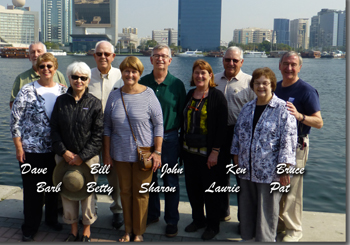 After a surprisingly good night’s sleep, we were up and out to breakfast
at 7. Our tour, which was
scheduled for 9, was a bit delayed, and we finally rolled out around
9:45.
After a surprisingly good night’s sleep, we were up and out to breakfast
at 7. Our tour, which was
scheduled for 9, was a bit delayed, and we finally rolled out around
9:45.
This half day tour
took us to Old Dubai. That
is a relative term, as “old” refers to a section that was built in the
1950s. There was always a
town here, which was based on trade, fishing and pearl diving.
Oil was discovered in the 1960s/70s, and instantly, everyone in
the local tribe had $17 million dollars at their disposal.
As I mentioned, the rulers determined that the oil revenue would
be finite. In reality, there
were seven small sheikdoms in the area, which grouped together to form
the United Arab Emirates. It
is a federal setup, with each city state able to
 do pretty much whatever
it wants, other than matters which relate to all, such as currency,
immigration, etc. The tribal
members, to whom I shall refer as natives, are quite well off.
And the system is rigged to make certain they stay that way.
You cannot start a business here without a native representative.
And then you have the pay initial and periodic maintenance
licensing fees. As you might
expect, the royal families have their hands in virtually all of the
businesses. Emirates
Airlines is owned by the local ruling family, as are many of the
buildings, construction operations, and the like.
You cannot emigrate to the UAE unless you have a job.
And if you lose the job, you have 20 days to find a new one, or
you must leave the country. You must
also leave the country when you retire.
It is the businesses concern to keep track of their employees, as if
they are discovered to have let someone be discharged, and the person
does not leave the country, the company is blacklisted.
There is no UAE citizenship granted at birth, as in the USA.
Only about 18% of the total population is native to the UAE. So if you are one
of the chosen few, life is fabulous.
If not, you are pretty much screwed.
This sort of offends my sense of “everyone has an equal chance to
get ahead,” but it’s their operation.
do pretty much whatever
it wants, other than matters which relate to all, such as currency,
immigration, etc. The tribal
members, to whom I shall refer as natives, are quite well off.
And the system is rigged to make certain they stay that way.
You cannot start a business here without a native representative.
And then you have the pay initial and periodic maintenance
licensing fees. As you might
expect, the royal families have their hands in virtually all of the
businesses. Emirates
Airlines is owned by the local ruling family, as are many of the
buildings, construction operations, and the like.
You cannot emigrate to the UAE unless you have a job.
And if you lose the job, you have 20 days to find a new one, or
you must leave the country. You must
also leave the country when you retire.
It is the businesses concern to keep track of their employees, as if
they are discovered to have let someone be discharged, and the person
does not leave the country, the company is blacklisted.
There is no UAE citizenship granted at birth, as in the USA.
Only about 18% of the total population is native to the UAE. So if you are one
of the chosen few, life is fabulous.
If not, you are pretty much screwed.
This sort of offends my sense of “everyone has an equal chance to
get ahead,” but it’s their operation.
 The first thing in Old Dubai was a stop at the al Jumierah Mosque.
With the minarets and the curved domes, it looked, well, like a
mosque. Unlike other
countries, we were not allowed inside.
The first thing in Old Dubai was a stop at the al Jumierah Mosque.
With the minarets and the curved domes, it looked, well, like a
mosque. Unlike other
countries, we were not allowed inside.
 Next stop was a settlement of original homes, which were offered
to Iranian business people.
They were encouraged to come here to get commerce started, and their
original area has been preserved as a museum and heritage site.
One of the houses was open,
complete with wind towers used to catch the wind, and cool it as it
flowed down into the house. Note
the latticework and sculpted columns.
Next stop was a settlement of original homes, which were offered
to Iranian business people.
They were encouraged to come here to get commerce started, and their
original area has been preserved as a museum and heritage site.
One of the houses was open,
complete with wind towers used to catch the wind, and cool it as it
flowed down into the house. Note
the latticework and sculpted columns.
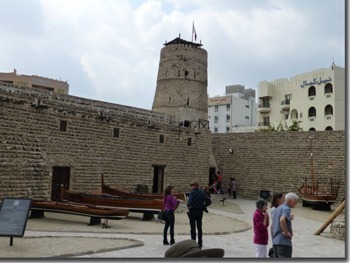 We did hit a museum,
which was housed in the old fort. It offered the usual displays of the limited
history. While the area has
been occupied for some time, the oldest items were a fort which dated to
the late 1800s. Water is an
issue, and most of today’s water comes from desalinization and heat
generated by an aluminum smelting operations.
And there are still quite a few artesian wells still around.
We did hit a museum,
which was housed in the old fort. It offered the usual displays of the limited
history. While the area has
been occupied for some time, the oldest items were a fort which dated to
the late 1800s. Water is an
issue, and most of today’s water comes from desalinization and heat
generated by an aluminum smelting operations.
And there are still quite a few artesian wells still around.
Next stop was the usual walk through of the old souk (market) with
colorful textiles and the ubiquitous sales guys trying to sell the
tourists Arabic head wear and shoes.
The gold souk was rather interesting, with lots of – you guessed
it – gold, silver and platinum.
There was also the spice market with the usual bins of whatever
you wanted in the spice line.
silver and platinum.
There was also the spice market with the usual bins of whatever
you wanted in the spice line.
Old Dubai is separated from New Dubai by Dubai Creek. We took a water taxi across, and headed back to the hotel.
 We got back to the hotel, had a late lunch, and Barb and I walked
over to the attached Dubai Mall.
It is the largest mall in the world, and every high end name
brand was here. The center
showpiece is a huge aquarium, complete with penguins.
We are tired. I’m
napping.
We got back to the hotel, had a late lunch, and Barb and I walked
over to the attached Dubai Mall.
It is the largest mall in the world, and every high end name
brand was here. The center
showpiece is a huge aquarium, complete with penguins.
We are tired. I’m
napping.
 Later.
We walked through the Mall to another hotel, and Neos, a bar on
the 63rd floor of an adjacent building.
It was a bit of an adventure to find this place, as we had to
take three separate elevators.
We had a great view of the water fountains, and some pretty
dazzling lighting. To see a clip of
the fountains, go here.
Later.
We walked through the Mall to another hotel, and Neos, a bar on
the 63rd floor of an adjacent building.
It was a bit of an adventure to find this place, as we had to
take three separate elevators.
We had a great view of the water fountains, and some pretty
dazzling lighting. To see a clip of
the fountains, go here.
This
place is pretty glitzy. But
then, so is Las Vegas. This
place just reeks of money. My
first impression is Disneyland meets Las Vegas.
I am disappointed though, as I
have only seen two Ferraris and one Rolls Royce.
The Benzs, Porsches and Lexuses are too numerous to mention.
We are all beat.
Tuesday, February 11
 After
a pretty good night’s sleep, we headed out to the Mall (again, the
largest in the world, with over a million square feet) to ride to the
observation deck of the Burj al Khalifa – the 124th floor.
That seemed to be about two thirds of the way to the top.
It was a pretty impressive experience.
The elevator is the world’s fastest, and took us up in just about
60 seconds. Yet there was no
sensation of movement. The
elevator was dark, except for moving light displays that mitigate your
sense of movement.
After
a pretty good night’s sleep, we headed out to the Mall (again, the
largest in the world, with over a million square feet) to ride to the
observation deck of the Burj al Khalifa – the 124th floor.
That seemed to be about two thirds of the way to the top.
It was a pretty impressive experience.
The elevator is the world’s fastest, and took us up in just about
60 seconds. Yet there was no
sensation of movement. The
elevator was dark, except for moving light displays that mitigate your
sense of movement.

The 360 degree views from the top were impressive. The whole city was laid at our feet, and looked a little like Legoland. After seeing photos, our older son commented that there was more concrete here than in all of Vermont.
You could see the World
 Islands,
but we were just too far away from the Palm Island to see much more than
the distant shape of the Burj Al Arab.
You have to remember that this whole place is only about 30-40
years old, so construction is still going on.
Our guide said that prior to the financial crisis, about 30% of
all the world’s construction cranes were in use here.
The rail system is still under construction, but when complete,
is supposed to be the longest in the world.
It is currently the flattest!
Islands,
but we were just too far away from the Palm Island to see much more than
the distant shape of the Burj Al Arab.
You have to remember that this whole place is only about 30-40
years old, so construction is still going on.
Our guide said that prior to the financial crisis, about 30% of
all the world’s construction cranes were in use here.
The rail system is still under construction, but when complete,
is supposed to be the longest in the world.
It is currently the flattest!
There seemed to me to be a theme here – tallest, longest, richest, biggest. We wondered where all the workers live. As it turns out, they are all in new housing on the outskirts of the city.
 From
the tower, we headed out to see New Dubai (again, a relative term) which
included a stop at Jumeirah Beach, with the Burj Al Arab in the
background. We were not able
to go to the hotel, as you have to have a reservation to get in.
From
the tower, we headed out to see New Dubai (again, a relative term) which
included a stop at Jumeirah Beach, with the Burj Al Arab in the
background. We were not able
to go to the hotel, as you have to have a reservation to get in.
 Barb
and I both got either hands or feet in the Persian Gulf, so we can check
off one more body of water from our list.
Barb
and I both got either hands or feet in the Persian Gulf, so we can check
off one more body of water from our list.
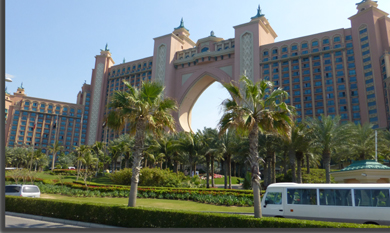 We
did drive out on the Palm Island, to the Atlantis Resort.
Again, without a reservation, there is no admittance.
There was plenty of housing along the palm fronds, and as we
passed, you could see the streets curving away “down the fronds.”
All the real estate was new and looked to be well occupied.
But Barb did think that there were many unoccupied apartments in
the buildings.
We
did drive out on the Palm Island, to the Atlantis Resort.
Again, without a reservation, there is no admittance.
There was plenty of housing along the palm fronds, and as we
passed, you could see the streets curving away “down the fronds.”
All the real estate was new and looked to be well occupied.
But Barb did think that there were many unoccupied apartments in
the buildings.
 Next
stop was the marina, with additional spectacular examples of
architecture. There were a
few boats at dock, although the really large yachts were out in the bay.
My brother picked up a real estate booklet.
Housing is expensive, with nothing listed under at least
US$1,000,000.
Next
stop was the marina, with additional spectacular examples of
architecture. There were a
few boats at dock, although the really large yachts were out in the bay.
My brother picked up a real estate booklet.
Housing is expensive, with nothing listed under at least
US$1,000,000.
 The
final stop was Ski Dubai, one of the more bizarre items in this city.
It is a fully functional ski slope, built in the Emirates Mall,
the second largest mall in the world.
You can rent all your equipment, and – Ski Dubai.
In the desert. In 125
degree heat! Go figure.
Take note of the snowman and the ski lift. And yes, the snow is
real.
The
final stop was Ski Dubai, one of the more bizarre items in this city.
It is a fully functional ski slope, built in the Emirates Mall,
the second largest mall in the world.
You can rent all your equipment, and – Ski Dubai.
In the desert. In 125
degree heat! Go figure.
Take note of the snowman and the ski lift. And yes, the snow is
real.
We had a brief lunch in the Mall, and headed back to the hotel. One of our party summed up an impression of Dubai – “Where a million dollars is pocket change.” To me, it was really odd – sort of like an adult Disneyland, all planned and constructed as a façade to wealth. I wonder what the internal politics are? Again, for the 18% that is native, life is fabulous. Free education, medical, virtually all your needs met. But for the rest, not so much, with a portion paid for medical, strict work and immigration rules, and not a chance of getting economically anywhere near the natives.
 Later.
We walked the Mall to a local restaurant featuring Emirates style
food. After perusing the
iPad menu, which showed photos of all the dishes, Barb and I bailed out
and went back to the pool at the hotel.
A light dinner outdoors was perfect, even though it was chilly
and windy. We may starve in
India. Of note were the
number of patrons who ordered up hookahs.
The night time view from the hotel is just as glitzy as the day
time view. This was our
final night in Dubai, as we leave for New Delhi tomorrow at noon.
For me, two days here was quite enough.
It was fun to see this new city, but neither of us feels the need
to return.
Later.
We walked the Mall to a local restaurant featuring Emirates style
food. After perusing the
iPad menu, which showed photos of all the dishes, Barb and I bailed out
and went back to the pool at the hotel.
A light dinner outdoors was perfect, even though it was chilly
and windy. We may starve in
India. Of note were the
number of patrons who ordered up hookahs.
The night time view from the hotel is just as glitzy as the day
time view. This was our
final night in Dubai, as we leave for New Delhi tomorrow at noon.
For me, two days here was quite enough.
It was fun to see this new city, but neither of us feels the need
to return.
I may have been too harsh in my initial comments about this city. If I were going to build a new, modern commerce hub, I think I’d probably go about it the same way. The streets are wide, there is plenty of mass transit, the freeways are all over built. Office towers and living spaces are integrated into neighborhoods, and there is plenty of recreation and green space.
 I
walked to the metro station this morning, which was about a 15 minute
walk from the hotel. The
walk is all indoors on slide ways in climate controlled pedestrian
bridges. The rail network is
modern (well, it is new) and appears to be broad gauge.
I did not ride, as time did not permit such action.
The trains run every 10 minutes or so.
The stations look like something straight out of the future.
I
walked to the metro station this morning, which was about a 15 minute
walk from the hotel. The
walk is all indoors on slide ways in climate controlled pedestrian
bridges. The rail network is
modern (well, it is new) and appears to be broad gauge.
I did not ride, as time did not permit such action.
The trains run every 10 minutes or so.
The stations look like something straight out of the future.
 The
freeway to the airport passed through a great deal of additional
construction. I heard
someone say that the skyline looked like it had just stepped out of Star
Wars. It really is amazing,
rising shining and gleaming from the desert.
So we bid good bye to this new city, on the shores of the Persian
Gulf. It would be
interesting to see the place in another ten years.
I probably would not recognize it.
The pickup for our flight to New Delhi is at Noon.
On we go.
The
freeway to the airport passed through a great deal of additional
construction. I heard
someone say that the skyline looked like it had just stepped out of Star
Wars. It really is amazing,
rising shining and gleaming from the desert.
So we bid good bye to this new city, on the shores of the Persian
Gulf. It would be
interesting to see the place in another ten years.
I probably would not recognize it.
The pickup for our flight to New Delhi is at Noon.
On we go.
My, but the Emirates terminal at the airport is
huge. I just can’t get over
how large everything is.
Excess capacity was certainly built into everything.
After a short delay, our flight to Delhi departed, flew the 1500
miles, and arrived around 8 PM, local, with a 2 ½ hour time shift.
All of India is on the same time zone.
The traffic on the way into town was a bit more frantic than
Dubai. That means that the
lane markers were sometimes just a suggestion.
We arrived safely, and are tucked in our rooms.
India is the second most populated country in the world, with 1.3
billion souls. Delhi alone
has 16 million inhabitants.
Tomorrow we start our official India tour.
 The
Claridges Hotel is located closer into the city. It was a
beautiful hotel, but the odd thing was
the "window" in our room was really just a blacked out piece of sheet metal,
hiding - what?
The
Claridges Hotel is located closer into the city. It was a
beautiful hotel, but the odd thing was
the "window" in our room was really just a blacked out piece of sheet metal,
hiding - what?
I was up early exploring, and the first sight on
the street was a small taxi.
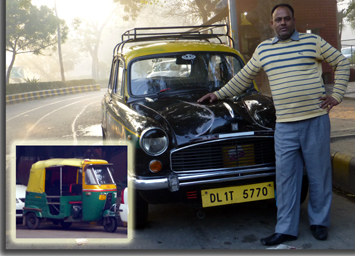 Inquiries indicate that this is a sedan made by Hindustani Motors.
We would end up seeing a lot of these. A larger variety, the
Ambassador model, will be seen used by government officials. I
think the driver said this model was was around the 1960s, but I can't
be certain. And my first look at the tuk tuk means of conveyance.
Inquiries indicate that this is a sedan made by Hindustani Motors.
We would end up seeing a lot of these. A larger variety, the
Ambassador model, will be seen used by government officials. I
think the driver said this model was was around the 1960s, but I can't
be certain. And my first look at the tuk tuk means of conveyance.
 Our
tour guide, Uden Sherpa (yes, he is a Sherpa from Darjeeling), showed up right on time.
He introduced us to our day guide, and off we went.
The first stop was the largest mosque in India, which was located
in Old Delhi. Called the
Friday Mosque, it is capable of handling 20,000 people, it was all done
up in marble and stone. It
was located close to the Red Fort, some of which was destroyed by the
British in the 1800s.
Our
tour guide, Uden Sherpa (yes, he is a Sherpa from Darjeeling), showed up right on time.
He introduced us to our day guide, and off we went.
The first stop was the largest mosque in India, which was located
in Old Delhi. Called the
Friday Mosque, it is capable of handling 20,000 people, it was all done
up in marble and stone. It
was located close to the Red Fort, some of which was destroyed by the
British in the 1800s.

The ladies did have to get properly dressed for admittance.
 Old Delhi is – well, old, with narrow streets,
and once lovely homes now fallen
into disrepair. Access is
via motor scooters, tuk tuk, bicycle rickshaws, and in some cases, animal carts.
Traffic is the usual third world snarl, but everyone drives with
accelerator and horn, and while the misses are close, accidents seem to
be rare. The cars are
smaller and speeds are not really all that high.
There is just a lot of traffic.
Our driver told us you need to drive in India is "good brakes, good
horn, and good luck."
Old Delhi is – well, old, with narrow streets,
and once lovely homes now fallen
into disrepair. Access is
via motor scooters, tuk tuk, bicycle rickshaws, and in some cases, animal carts.
Traffic is the usual third world snarl, but everyone drives with
accelerator and horn, and while the misses are close, accidents seem to
be rare. The cars are
smaller and speeds are not really all that high.
There is just a lot of traffic.
Our driver told us you need to drive in India is "good brakes, good
horn, and good luck."
 Electrical
in the old city was the usual maze of wiring.
It is said that you may be using electricity from one person,
while paying for another – if at all.
Electrical
in the old city was the usual maze of wiring.
It is said that you may be using electricity from one person,
while paying for another – if at all.
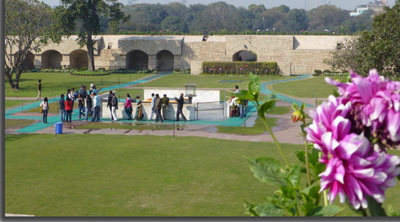
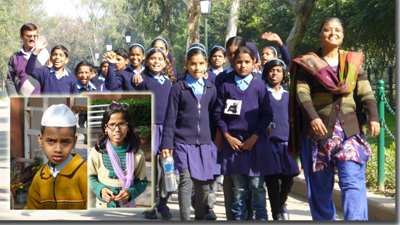 There
were school tours, and one young woman who gave me her name, which I
can’t begin to pronounce.
There
were school tours, and one young woman who gave me her name, which I
can’t begin to pronounce.

Delhi is very green, with lots of parks and open spaces. Yes, there are people sleeping in the medians and along the roads, and piles of garbage . But I didn’t think it to be overwhelming.
Next, we hit the obligatory rug shop and craft store – snacks and purchases. Our attempt to increase the Indian economy commenced. After melting multiple Visa cards, we were on to the national museum, with displays of coins, armaments and textiles. There were examples of war elephants, and small cannons used on top of the animals (elephant guns).
 We
did a quick drive by of the Presidents palace and the congressional
office buildings.
We
did a quick drive by of the Presidents palace and the congressional
office buildings.
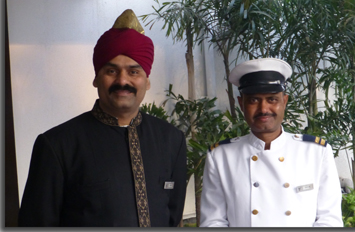 And
we were shifted back to the hotel, where we had a quiet dinner in the
bar. There are more people
here tonight. A large group
of UK tourists is here, and so we got shut out of the main dining room.
The rest of our group went for Chinese, but we opted for a quiet
time, as we are both tired.
The assistant beverage manager stopped by our table to inquire how thing
were going. We chatted for a
bit. So far, and this is
very limited experience, we have been impressed with the
politeness and friendliness of everyone we have encountered.
The staff at Claridges Hotel has been outstanding.
And
we were shifted back to the hotel, where we had a quiet dinner in the
bar. There are more people
here tonight. A large group
of UK tourists is here, and so we got shut out of the main dining room.
The rest of our group went for Chinese, but we opted for a quiet
time, as we are both tired.
The assistant beverage manager stopped by our table to inquire how thing
were going. We chatted for a
bit. So far, and this is
very limited experience, we have been impressed with the
politeness and friendliness of everyone we have encountered.
The staff at Claridges Hotel has been outstanding.
Happy Valentines Day! We were up and out to catch an Air India flight to Varanasi. There was a bit of a delay at the airport, as the computer system sputtered, and there were a whole bunch of tour guides with multiple passports trying to get boarding passes. After much checking of carry-on items, and weighting them (hear that US airlines?), and checking sizes, we were off.
 It was only a short hop to this, the most holy
of Indian cities. Varanasi
sits between two tributaries of the Ganges, the Varana and the Asi.
Millions of pilgrims visit this city each year for whom the River
Ganges, physically polluted by both the living and the dead, remains
spiritually pristine enough to cleanse the spirit.
It was only a short hop to this, the most holy
of Indian cities. Varanasi
sits between two tributaries of the Ganges, the Varana and the Asi.
Millions of pilgrims visit this city each year for whom the River
Ganges, physically polluted by both the living and the dead, remains
spiritually pristine enough to cleanse the spirit.
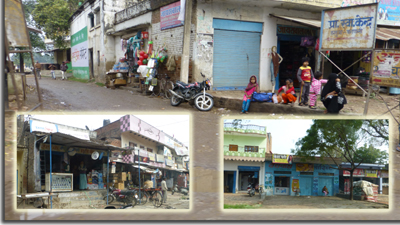 We were picked up by our city guide, Atanu, and
three Toyota wagons, for about an hour and a half drive into town.
The poverty level here is much more severe than we had seen in
Delhi, but about on par with any third world country.
The drive into town as a bit more of what we had expected to see.
So there were lots of small shops, work being done in the street, and
animals all over the place. And plenty of garbage in the form or
plastic and paper.
We were picked up by our city guide, Atanu, and
three Toyota wagons, for about an hour and a half drive into town.
The poverty level here is much more severe than we had seen in
Delhi, but about on par with any third world country.
The drive into town as a bit more of what we had expected to see.
So there were lots of small shops, work being done in the street, and
animals all over the place. And plenty of garbage in the form or
plastic and paper.
Driving is a challenge, as traffic is much more free flowing than in the larger city. So bicycles, tuk-tuks, rickshaws, cows, goats, pedestrians, motor scooters, trucks and cars all intermingle and fight for the same space. I think I could have driven into the city limits. But after that, it got to the point where you really had to grow up with it. Traffic pulls out in front of each other, barely misses, and just keeps on flowing. Lane markers are merely a suggestion, as are signs. One does not stop and look prior to entering traffic. You just sort of pull out, and the seas part for you. Want to make a U Turn in the middle of traffic? No problem. You just do it. In one instance, we backed up on the freeway because the driver missed an exit. Again, no problem. It all works, but it looks pretty crazy. I was afraid to put my hand out the window to better capture the traffic, but the vehicles are so close, I thought it prudent to keep my limbs.
 As I said, the city is the center of the Hindu
religion, with temples, and most importantly, direct access to the
Ganges. The Ganges is
considered to be the holy river of Hinduism, as it flows from heaven in
the northern mountains, and on to the sea.
Hindus wish to make a pilgrimage to the Ganges, to bathe, and
have the water bless them.
And when they die, their bodies are to be cremated and ashes scattered
in the river. As a result,
Varanasi has many hospices, and end of days centers.
And funeral pyres burn on the shores day and night.
And as you will remember, cows are everywhere. As are their by products. One must be very cautious
not to "cut the cake" (step in a cow pie.)
As I said, the city is the center of the Hindu
religion, with temples, and most importantly, direct access to the
Ganges. The Ganges is
considered to be the holy river of Hinduism, as it flows from heaven in
the northern mountains, and on to the sea.
Hindus wish to make a pilgrimage to the Ganges, to bathe, and
have the water bless them.
And when they die, their bodies are to be cremated and ashes scattered
in the river. As a result,
Varanasi has many hospices, and end of days centers.
And funeral pyres burn on the shores day and night.
And as you will remember, cows are everywhere. As are their by products. One must be very cautious
not to "cut the cake" (step in a cow pie.)
 Let's
have a short discourse on cows. I, like pretty much everyone else,
thought that cows were sacred. Not so fast. In Hinduism, the
cow is revered as a source of food, a symbol of life, and not to be
killed. Do not interpret this as Hindu's worship cows.
Better to say that cows are taboo in the Hindu religion. The
animal does provide milk, curds, ghee butter, urine and dung (for fuel).
The animals are owned by someone, and while they have free range, the
animals do return to their owners. Most rural families have at
least one dairy cow. So better you should say that the cow is a
protected species in [mostly] vegetarian India.
Let's
have a short discourse on cows. I, like pretty much everyone else,
thought that cows were sacred. Not so fast. In Hinduism, the
cow is revered as a source of food, a symbol of life, and not to be
killed. Do not interpret this as Hindu's worship cows.
Better to say that cows are taboo in the Hindu religion. The
animal does provide milk, curds, ghee butter, urine and dung (for fuel).
The animals are owned by someone, and while they have free range, the
animals do return to their owners. Most rural families have at
least one dairy cow. So better you should say that the cow is a
protected species in [mostly] vegetarian India.
 Life
on the ghats, or steps leading into the river, goes on all the time.
So washing, bathing, just being in the water is a sight that is always
present.
Life
on the ghats, or steps leading into the river, goes on all the time.
So washing, bathing, just being in the water is a sight that is always
present.
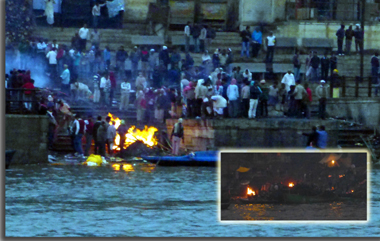 It was rainy, but we took at boat out on the
water to see two things. The
first was the funeral or cremation sites.
The bodies are anointed with clarified butter, and sandal wood is
used for the burning. So
there is no smell. An
“untouchable” works the fires, and after complete consumption, scatters
some of the ash in the river.
These “untouchable” folks can be quite well to do, even though
they are the lowest caste.
They are paid by the families for their work, and they have the right to
mine the gold and silver jewelry that accompanies the body.
It was rainy, but we took at boat out on the
water to see two things. The
first was the funeral or cremation sites.
The bodies are anointed with clarified butter, and sandal wood is
used for the burning. So
there is no smell. An
“untouchable” works the fires, and after complete consumption, scatters
some of the ash in the river.
These “untouchable” folks can be quite well to do, even though
they are the lowest caste.
They are paid by the families for their work, and they have the right to
mine the gold and silver jewelry that accompanies the body.
 The second item was the singing ritual that puts
the Ganges to sleep. It was
colorful, and about as atonal as any Indian music sounds to western
ears. Back to our hotel and dinner was local fare,
all of which was vegetarian.
The second item was the singing ritual that puts
the Ganges to sleep. It was
colorful, and about as atonal as any Indian music sounds to western
ears. Back to our hotel and dinner was local fare,
all of which was vegetarian.
Click here for video.
 I
was up and out early this morning, as the meeting time was 0600.
Barb and several others wisely opted to stay back in bed.
The majority of us stumbled down the dark stairs to the rather
raggedy boat from last night, with it's one lung (cylinder) engine and
hand cranked starter.
I
was up and out early this morning, as the meeting time was 0600.
Barb and several others wisely opted to stay back in bed.
The majority of us stumbled down the dark stairs to the rather
raggedy boat from last night, with it's one lung (cylinder) engine and
hand cranked starter.
At this point, the Ganges actually flows north, as it makes a big loop. The idea this morning was to cruise and see the rising sun hit the buildings along the Ganges. These are all built facing east, so I’m sure the sunrise would have been spectacular. But it was misty and rainy today, so we did the best we could.
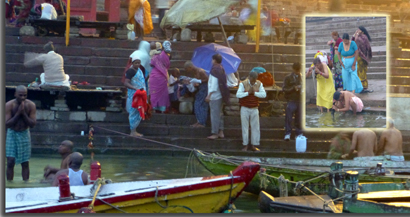 There
are over 90 sets of ghats or steps down to the water.
The bathing and Hindu ceremonies continued, even at this early
hour.
There
are over 90 sets of ghats or steps down to the water.
The bathing and Hindu ceremonies continued, even at this early
hour.

The boatman and his assistant did a masterful job of getting us around the motor and hand powered traffic.
 One
interesting thing was the ability to put wishing floats into the river.
These are just little floats with a chunk of lighted wax and
marigolds. You pay your ten
rupees, make a wish, and set the float free.
One
interesting thing was the ability to put wishing floats into the river.
These are just little floats with a chunk of lighted wax and
marigolds. You pay your ten
rupees, make a wish, and set the float free.
 After
breakfast, we walked out of several alleys to get to a point where the
cars could pick us up. Our
journeys today were a bit like Mr. Toad’s Wild Ride.
Cars, trucks, bicycles, pedestrians, rickshaws, motor bikes, tuk
tuks, dogs, pigs, and cows all share the same roadway.
The saying is, “You need good brakes, a good horn, and good luck”
to drive in India. And
nowhere was it more apparent than here.
The streets are narrow, and two cars will cram into each lane,
along with bikes, scooters and pedestrians.
The bike loads are impressive.
I’ve seen men pedaling with loads of rebar, huge bundles, long
bamboo poles, goats, chickens, and pretty much everything that can be
transported. I even saw a
tuk tuk with a semi-trailer!
After
breakfast, we walked out of several alleys to get to a point where the
cars could pick us up. Our
journeys today were a bit like Mr. Toad’s Wild Ride.
Cars, trucks, bicycles, pedestrians, rickshaws, motor bikes, tuk
tuks, dogs, pigs, and cows all share the same roadway.
The saying is, “You need good brakes, a good horn, and good luck”
to drive in India. And
nowhere was it more apparent than here.
The streets are narrow, and two cars will cram into each lane,
along with bikes, scooters and pedestrians.
The bike loads are impressive.
I’ve seen men pedaling with loads of rebar, huge bundles, long
bamboo poles, goats, chickens, and pretty much everything that can be
transported. I even saw a
tuk tuk with a semi-trailer!

Everywhere you looked, there was color! The displays along the streets, and the vendor stalls were all riotous in color.
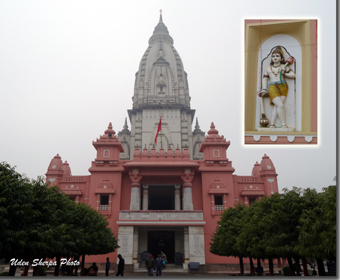 We
went to the Benares Hindu University, which is a renowed center for
Sanskrit learning and Hindu philosophy. We drove through the
extensive grounds, and stopped at the main Hindu temple, the Shree
Vishwanath Mandir. The
golden statue of Brahma inside was pretty amazing, as were the frescos
along the walls. Note that every
time you see a statue of Brahma, you will also find a statue of a bull.
Note that the depictions of the Hindu gods are relatively childlike in
features. Westerners see them as somewhat feminine, but that is
not the intention.
We
went to the Benares Hindu University, which is a renowed center for
Sanskrit learning and Hindu philosophy. We drove through the
extensive grounds, and stopped at the main Hindu temple, the Shree
Vishwanath Mandir. The
golden statue of Brahma inside was pretty amazing, as were the frescos
along the walls. Note that every
time you see a statue of Brahma, you will also find a statue of a bull.
Note that the depictions of the Hindu gods are relatively childlike in
features. Westerners see them as somewhat feminine, but that is
not the intention.
 To
provide some equal religious time, the next stop was to Sarnath, a
Buddhist shrine where Lord Buddha gave his first major sermon after
gaining enlightenment.
To
provide some equal religious time, the next stop was to Sarnath, a
Buddhist shrine where Lord Buddha gave his first major sermon after
gaining enlightenment.
 The
tree shading the place was said to several thousand years old. I
think that they meant that the lineage of the tree, rather than the tree
itself.
The
tree shading the place was said to several thousand years old. I
think that they meant that the lineage of the tree, rather than the tree
itself.
Next, we hit the Museum of Archeology, with the prize piece of a four faced lion statue, with significance in the Buddhist religion. Four animals are depicted, indicating the various affiliations with Buddha - horse, elephant, lion and tiger. There was no gift shop, and we were besieged by street vendors, as well as beggars. We ended up with some small souvenir pieces, and headed on another wild ride to lunch at a nice hotel.
This place was an oasis in the middle of madness. Sitting in the dining room, you would never know of the poverty, and teeming masses just a half a block away. It was a rather strange situation although we would find places like this all along our journey.
 Next
stop was the silk making factory, where many succumbed to silk wall
hangings, bedspreads and scarves.
The punch card system for a somewhat "automated" weaving system was a
interest. I noticed large banks of deep cycle batteries
sort of hidden under a stairs.
My question as to relevance was answered with the statement, “We
get a lot of power outages.”
As the power at the hotel seems relatively unstable, I wonder if all
businesses have such backups. (Our hotel had a generator)
Next
stop was the silk making factory, where many succumbed to silk wall
hangings, bedspreads and scarves.
The punch card system for a somewhat "automated" weaving system was a
interest. I noticed large banks of deep cycle batteries
sort of hidden under a stairs.
My question as to relevance was answered with the statement, “We
get a lot of power outages.”
As the power at the hotel seems relatively unstable, I wonder if all
businesses have such backups. (Our hotel had a generator)
We bailed out and went back to the hotel, while some continued on to the wood carving shop, where more money was left to support the Indian economy. Our city guide left us at this point. He was a well spoken, very knowledgeable man, patient and able to tell the history of each visited site with authority and depth.
 I
have forgotten to mention our hotel.
The Surya Uday Haweli Hotel is located on the Shivala Ghat, or
steps, right next to Ganges.
It has an open courtyard, and is filled with flowers and two tall trees.
It was quite pleasant tonight to sit, sip a cup of tea, and
listen to Indian music being played by three older men.
In some respects, it felt like I was back in the 60s, with Ravi
Shankar on the stereo and black light posters.
But sitting there was very relaxing, and allowed me to reflect on
the day’s events.
I
have forgotten to mention our hotel.
The Surya Uday Haweli Hotel is located on the Shivala Ghat, or
steps, right next to Ganges.
It has an open courtyard, and is filled with flowers and two tall trees.
It was quite pleasant tonight to sit, sip a cup of tea, and
listen to Indian music being played by three older men.
In some respects, it felt like I was back in the 60s, with Ravi
Shankar on the stereo and black light posters.
But sitting there was very relaxing, and allowed me to reflect on
the day’s events.
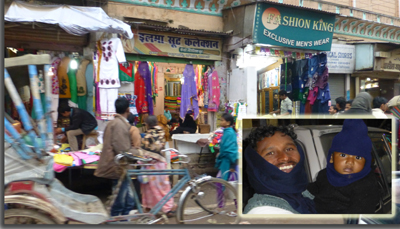 My
impressions of today are ones of so many people, stunning poverty and a
hard scrabble life. The
traffic was chaotic, yet everyone looked out for everyone else.
There seemed to be a sense of connectedness.
I couldn’t help but wonder if the next cancer cure was fermenting
in the mind of some person.
Or perhaps the next leader, or doctor, or poet was there.
It all just seemed so human.
I did not see a lot of people just standing around, looking
angry. Nor did I see any
overt aggression. I may be
missing things such as gangs and crime.
I will have to ask tomorrow.
The whole place seems to just work as a thriving organism.
Even with all the flith and garbage lying around, the individual shop
owners and people living in the shacks were sweeping their spaces trying
to keep some sort of order.
I may change my tune as we go forward on this exploration.
Time will tell.
My
impressions of today are ones of so many people, stunning poverty and a
hard scrabble life. The
traffic was chaotic, yet everyone looked out for everyone else.
There seemed to be a sense of connectedness.
I couldn’t help but wonder if the next cancer cure was fermenting
in the mind of some person.
Or perhaps the next leader, or doctor, or poet was there.
It all just seemed so human.
I did not see a lot of people just standing around, looking
angry. Nor did I see any
overt aggression. I may be
missing things such as gangs and crime.
I will have to ask tomorrow.
The whole place seems to just work as a thriving organism.
Even with all the flith and garbage lying around, the individual shop
owners and people living in the shacks were sweeping their spaces trying
to keep some sort of order.
I may change my tune as we go forward on this exploration.
Time will tell.
 Initially,
we thought that we might actually get to visit a diesel locomotive
factory, but, being Sunday, it seems that was a non-starter.
I hope this does not turn into an ABP tour (Another Bloody
Palace). Instead, we had to settle
for a faint sunrise over the Ganges.
Initially,
we thought that we might actually get to visit a diesel locomotive
factory, but, being Sunday, it seems that was a non-starter.
I hope this does not turn into an ABP tour (Another Bloody
Palace). Instead, we had to settle
for a faint sunrise over the Ganges.

Here is a rooftop view of the ghats from our hotel.

Instead, we walked the ghats to see everyday life early in the morning along the Ganges. Of course, now that we are leaving, the sun is coming out. The Ganges does flood every year during monsoon season. In 1975, it reached the bottom of the hotel, as you can see from the high water marker.

The crematoria just kept going. There are piles of wood along the steps and the roads, all gathered expressly for the purpose of cremation.
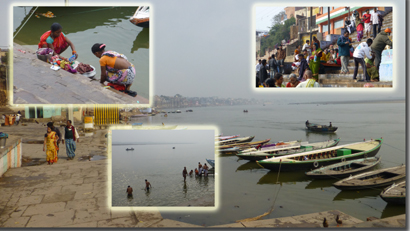
And all the time people were bathing, washing clothes, and just carrying on with daily life. The goats and cows were all over the place, and one of our party had her garland literally snatched from her by an aggressive goat.
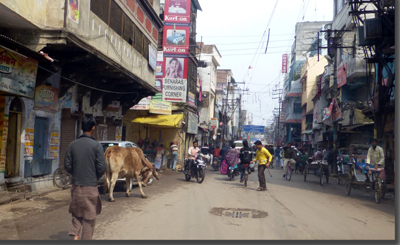 Late
morning we took another wild ride out to the airport.
The traffic can’t be described, and must be experienced.
This being Sunday, there were more people out and the streets
were packed. Our drivers
managed it all, mostly using the brake and the horn.
Some good luck was tossed in there as well.
While it isn’t scary, it is un-nerving, particularly when they
cars got going a bit faster on the outskirts of town.
Late
morning we took another wild ride out to the airport.
The traffic can’t be described, and must be experienced.
This being Sunday, there were more people out and the streets
were packed. Our drivers
managed it all, mostly using the brake and the horn.
Some good luck was tossed in there as well.
While it isn’t scary, it is un-nerving, particularly when they
cars got going a bit faster on the outskirts of town.
The airport was the usual hurry and wait, with the plane delayed an hour. My seatmate was a young man who was getting his doctorate in quantum computing. Talk about feeling a little inferior.
So we leave Varanasi, the City of Light. It was an interesting place to visit. The town was an experience, and the hotel was perfect for what we saw. However, I am glad that this was the start of the trip, and not the final impression.
We arrived back in Delhi, checked back in at The
Claridges, had a drink, and went
to bed. The bartenders
remembered us. Is that good
sign? Tomorrow we begin
touring by bus.
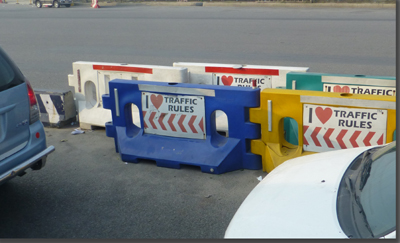 Our
journey this morning took us on the new Varunda Freeway, which connects
Delhi and Agra. Once we got
out of the Delhi traffic, which was pretty tame, considering the last
two days, we found ourselves in rural India.
There were many rice and mustard fields, as well as brick
factories; lots and lots of brick
factories.
Our
journey this morning took us on the new Varunda Freeway, which connects
Delhi and Agra. Once we got
out of the Delhi traffic, which was pretty tame, considering the last
two days, we found ourselves in rural India.
There were many rice and mustard fields, as well as brick
factories; lots and lots of brick
factories.
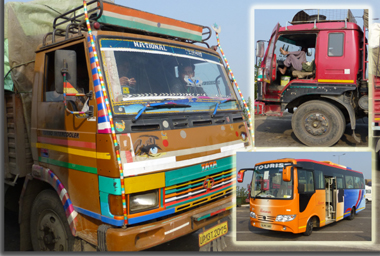 A
stop at a rest area/truck stop yielded some truck photos.
We also had some tea, which is flavored with cardamom and
cinnamon. It was quite
tasty. And I had to toss in a photo
of our home away from home for the next weeks, the comfortable DL1P C 5957 tour bus from
Mann. It has a few traffic scars, but was a comfy ride.
A
stop at a rest area/truck stop yielded some truck photos.
We also had some tea, which is flavored with cardamom and
cinnamon. It was quite
tasty. And I had to toss in a photo
of our home away from home for the next weeks, the comfortable DL1P C 5957 tour bus from
Mann. It has a few traffic scars, but was a comfy ride.
Our hotel in Agra tonight had been changed. The old adage of, “The better the room, the shorter the stay,” certainly was true. We are in the Jaypee Palace, which is simply fabulous. We were unable to enjoy it though, and immediately headed for the Taj Mahal.
 The
ride through town was the usual traffic snarl, except that camels were
added to the mix. And we started to see our first monkeys.
The
ride through town was the usual traffic snarl, except that camels were
added to the mix. And we started to see our first monkeys.
We met our city guide, one Anurag Saxena, a knowledgeable, pleasant man, who was quite entertaining.
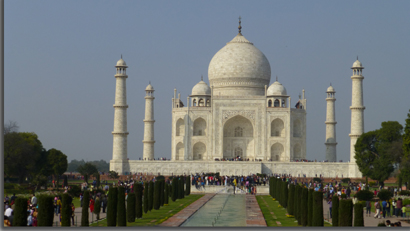 The
Taj Mahal has never really been on my “must see” list.
It was always sort of a “well, maybe it would be nice to visit”
list. However, that changed. One word sums it up - WOW!
This place is amazing.
It is no wonder that it is listed as one of the Seven Wonders of
the World. Built in white marble,
over a brick structure, it is a tomb for Mughal King Emperor Shah
Jahan’s beloved third wife Mumtaz, who died in childbirth.
As the legend goes, she asked him to build a monument so
beautiful, that the world would never forget their love.
I think he succeeded.
The
Taj Mahal has never really been on my “must see” list.
It was always sort of a “well, maybe it would be nice to visit”
list. However, that changed. One word sums it up - WOW!
This place is amazing.
It is no wonder that it is listed as one of the Seven Wonders of
the World. Built in white marble,
over a brick structure, it is a tomb for Mughal King Emperor Shah
Jahan’s beloved third wife Mumtaz, who died in childbirth.
As the legend goes, she asked him to build a monument so
beautiful, that the world would never forget their love.
I think he succeeded.
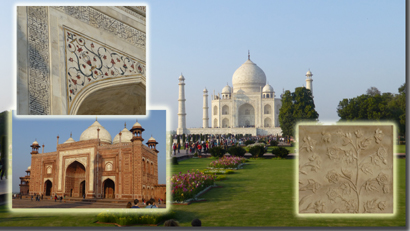 Built
in 1652, it took 22 years to build, the same number as the domes on the
gates that lead from the regular world (the outer courtyards) to heaven
(the monument itself). The
inlay is fantastic and it was really a wonder to see the place sparkling
in the sun. And it has never
been cleaned. The marble is
so hard and smooth, that it has never needed it.
Outbuildings were built for balance to the whole compound, and
one of them has never been used.
The whole compound is symetrical, with the exception of the two
tombs. While Mumtaz’s tomb
is in the center, the emperor’s is off to the side.
The whole thing is really a wonderous sight.
Built
in 1652, it took 22 years to build, the same number as the domes on the
gates that lead from the regular world (the outer courtyards) to heaven
(the monument itself). The
inlay is fantastic and it was really a wonder to see the place sparkling
in the sun. And it has never
been cleaned. The marble is
so hard and smooth, that it has never needed it.
Outbuildings were built for balance to the whole compound, and
one of them has never been used.
The whole compound is symetrical, with the exception of the two
tombs. While Mumtaz’s tomb
is in the center, the emperor’s is off to the side.
The whole thing is really a wonderous sight.

We all had Christmas card photos taken with the Taj in the background.
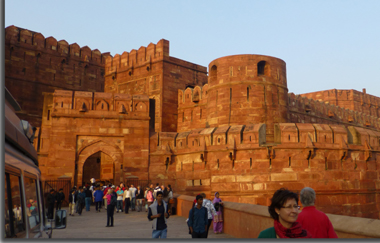 Our
next stop, late in the day, was the Agra Fort.
This is where the Mughal Emperor Jahan was under house arrest for
eight years, gazing at the tomb of his deceased wife.
He was imprisoned by his grandson, who had designs on the throne.
Our
next stop, late in the day, was the Agra Fort.
This is where the Mughal Emperor Jahan was under house arrest for
eight years, gazing at the tomb of his deceased wife.
He was imprisoned by his grandson, who had designs on the throne.
And this is where he died.

We were beat, and blew off the free dinner, for
a drink and snacks at the hotel.
It will be an early to bed night.
People are so friendly, and they all seem to realize that tourism
is a huge boon for the country.
Our day guide said that the films Slumdog Millionaire and Best
Marigold Hotel did more for the tourist industry than any other
promotion. So far, I’m glad
we came.
We left breadcrumbs so that we could find our way back to our room, after finally being directed to breakfast. I wish I could say that the food lived up to the room, but sadly, this was not the case.
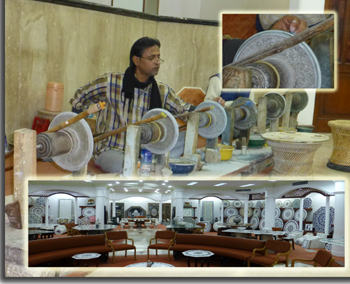 City guide
Anurag met us and initially took us to the obligatory artisan craft
store. Apparently the
technique for inlay work is a dying art, and the Indian government is
subsidizing artists to continue this work.
After a demonstration on how small pieces of jade, malachite,
carnelian. onyx, jasper, turquoise, coral, and lapis are formed and then inlaid into Agra marble, we were
let loose in the store. Let
me be brief and just say that the GDP of India increased several fold
due to our purchases. And to
think that we have three or four more cities to go.
Fortunately, these places all will ship.
City guide
Anurag met us and initially took us to the obligatory artisan craft
store. Apparently the
technique for inlay work is a dying art, and the Indian government is
subsidizing artists to continue this work.
After a demonstration on how small pieces of jade, malachite,
carnelian. onyx, jasper, turquoise, coral, and lapis are formed and then inlaid into Agra marble, we were
let loose in the store. Let
me be brief and just say that the GDP of India increased several fold
due to our purchases. And to
think that we have three or four more cities to go.
Fortunately, these places all will ship.
 Then we were off to
Fatehpur Sikri, the Red Fort of Agra.
This place is also on the World Heritage Site list.
A series of Muhgal emperors built this, and added on.
And then they added on some more. Of interest is that all these
forts were essentially public works projects. It kept the locals
employed, and moved money into the economy.
While the term “fort” is used, it really was a palace.
Then we were off to
Fatehpur Sikri, the Red Fort of Agra.
This place is also on the World Heritage Site list.
A series of Muhgal emperors built this, and added on.
And then they added on some more. Of interest is that all these
forts were essentially public works projects. It kept the locals
employed, and moved money into the economy.
While the term “fort” is used, it really was a palace.
 Only about ten percent of the place has been restored, but it was
huge. We walked and walked
and walked, seeing one red sandstone palace after another.
Incidentally, the sandstone here is quite hard, and can be
polished, unlike the soft American sandstone.
This place must have been fabulous in its day, with the rugs, and
silk covers. The gardens
were evident even today. And
imagine the people, the animals, the fountains, the harem girls.
Wow. It was pretty
spectacular as it was, but in the day it must have been beautiful.
Only about ten percent of the place has been restored, but it was
huge. We walked and walked
and walked, seeing one red sandstone palace after another.
Incidentally, the sandstone here is quite hard, and can be
polished, unlike the soft American sandstone.
This place must have been fabulous in its day, with the rugs, and
silk covers. The gardens
were evident even today. And
imagine the people, the animals, the fountains, the harem girls.
Wow. It was pretty
spectacular as it was, but in the day it must have been beautiful.
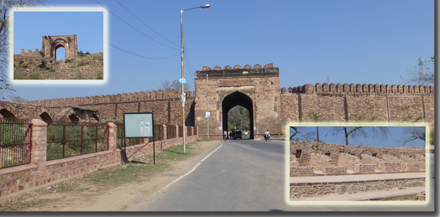
Our city guide left us at this point. Some of his information was very informative. He, like previous guides, spoke to the political corruption in India. The joke goes that a Russian, and American and an Indian meet God and are granted one question. The American asks, “When will the recession be over?” God Answers, “In 50 years.” The American starts crying, saying he will not be alive to see it. The Russian asks, “When will Russia be like the USA?” God answers, “In 50 years.” The Russian starts crying, saying that he will not be alive to see it. The Indian asks, “When will Indian political corruption cease?” God starts crying. Insert rim shot here. Another interesting thing that the guide pointed out was that there were no grocery stores. And I guess now that he mentioned it, no, there aren’t any. The reason is that push cart vendors bring fresh produce, meats, etc. into the neighborhoods and everyone buys from them. The government feels that this employs more people. Advance that thought to the fact that Walmart wants to enter the Indian market. It is meeting stiff resistance, as the government is trying to keep them, and all big box stores out. The feeling is that the small business vendors actually employ more people than the big chains. America? Do you hear?
Anyway, after the fort, we headed down the highway – a four lane toll road – to our next stop, which is Jaipur. A word on the toll road is necessary. Not only are cars and buses and trucks on the road, but so are tractors, camel carts, motorcycles, and every other wheeled conveyance. While there isn’t the close in combat of city driving, it is still a case of timing and nerve.
We are in the Trident Hotel, and get to do
laundry tomorrow. And we are
here for four nights.
Tomorrow we start our look at Jaipur.
So far, Barb and I have really enjoyed the sights and sounds of India.
We never thought we'd say that, but there you go.
People smile and wave.
The colors are bright and vivid.
While the living certainly isn’t what Westerners would call
wonderful, the place seems so alive.
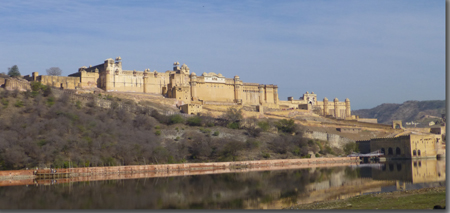 Welcome to Jaipur which was the first planned
city in northern India.
Started in 1727, the “Pink City” was conceived by Sawai Jai Singh.
Actually the place dates back to the 12th century,
when a fort was constructed here.
That fort eventually became the Amber Palace.
It is so named not for its color, but for the name of the rulers
who were first in the area.
Why the name of the “Pink City?”
That came about when the Price of Wales visited in 1876.
The city was painted a reddish color to mitigate the effects of
the sun. The “pink” is
actually a rather faded terra cotta color.
Note that city names that end in "pur" are Hindu cities,
Welcome to Jaipur which was the first planned
city in northern India.
Started in 1727, the “Pink City” was conceived by Sawai Jai Singh.
Actually the place dates back to the 12th century,
when a fort was constructed here.
That fort eventually became the Amber Palace.
It is so named not for its color, but for the name of the rulers
who were first in the area.
Why the name of the “Pink City?”
That came about when the Price of Wales visited in 1876.
The city was painted a reddish color to mitigate the effects of
the sun. The “pink” is
actually a rather faded terra cotta color.
Note that city names that end in "pur" are Hindu cities,
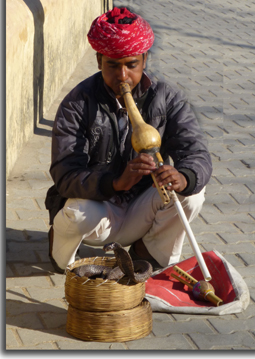 while cities
that end in "bad" are Muslim cities.
while cities
that end in "bad" are Muslim cities.
What would a trip to India be, without at least one "snake charmer?"
Our first trip this morning was through a mountain pass that the British had built during their time here. A short history lesson is in order. Rajasthan is the largest, richest and the least populated of the Indian states. The British were late to the game here, with the East India Company. While the Portuguese, Dutch and French were on the west side of India, the British had to settle for the north and east side of the sub-continent. While the others had good native relations, the British were intent only on profit, and moved troops into the country to maintain order and get things done their way. Eventually they pretty much took over the whole of the country. Enter the last governor of India, Lord Mountbatten. He recognized that the times, they were a'changin', and that Britain would not be able to hold on to India. So he decided on a route to independence. He set up the system which got a central government away from the Raj's, and moved the country to independence in 1947. As a way of appeasing the Raj’s, many of their holdings were put into trust for museum display, and our first stop, the Amber Palace was once of those put in trust.

We made a royal entrance to the place, swaying on the backs of elephants for the long trek up the mountain to the palace entrance.

The royal entrance. We swayed, and rocked, and felt like we were going to fall off. A fun time, had by all!
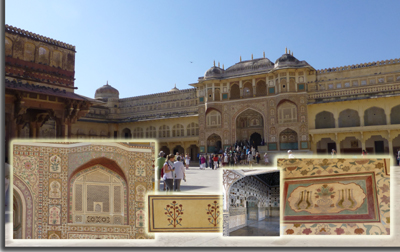 The
palace/fort is a
huge complex, with many vast courtyards, residence halls, harem
quarters, and pools. There
were warm areas for winter, and cool areas for summer.
Cooling was provided by using water tanks which dripped water in
reed mats – early swamp coolers.
There were many magnificent frescos and mirrored tile
ornamentation.
Unfortunately, there was a lot of standing around.
Our city guide was Naru, who knew his stuff, but was way more
detailed than I cared to know.
Finally we were released from the palace, and instead of
elephant, traveled back to the bus by jeep.
The elephants only work in the winters, and only allowed three
trips a day. We did see them
later being used to haul materials around town, which only added to the
already chaotic traffic.
The
palace/fort is a
huge complex, with many vast courtyards, residence halls, harem
quarters, and pools. There
were warm areas for winter, and cool areas for summer.
Cooling was provided by using water tanks which dripped water in
reed mats – early swamp coolers.
There were many magnificent frescos and mirrored tile
ornamentation.
Unfortunately, there was a lot of standing around.
Our city guide was Naru, who knew his stuff, but was way more
detailed than I cared to know.
Finally we were released from the palace, and instead of
elephant, traveled back to the bus by jeep.
The elephants only work in the winters, and only allowed three
trips a day. We did see them
later being used to haul materials around town, which only added to the
already chaotic traffic.
Not so limited in their working hours were the souvenir sellers. These guys are annoying and persistent. It was rather humorous, as they seemed to pester everyone but Barb. The key is to just ignore them, and eventually they move on to more susceptable pickings.
 We had a small lunch at a coffee shop which was
connected to a gas station.
Apparently Cafe Coffee Day, is India's answer to Starbucks. We
would see these places everywhere.
We had a small lunch at a coffee shop which was
connected to a gas station.
Apparently Cafe Coffee Day, is India's answer to Starbucks. We
would see these places everywhere.
 Across the street was a summer palace, which is being restored and soon
will be open to the public.
The place was built, and then the land scooped out and flooded to make
it appear to be in the middle of the lake.
Surprise, the lake is polluted.
Note that this is not the famous Lake Palace, which is located in
Udaipur. We will see that later.
Across the street was a summer palace, which is being restored and soon
will be open to the public.
The place was built, and then the land scooped out and flooded to make
it appear to be in the middle of the lake.
Surprise, the lake is polluted.
Note that this is not the famous Lake Palace, which is located in
Udaipur. We will see that later.

This area turns out to be popular with the locals, who gather in the afternoons and evenings. So there are a variety of sales people and food vendors, all of which are rich in color. Whether it be food or shoes, many items are available.

We made a brief, unscheduled stop right in the heart of the city at a city mausoleum.
Our attention was now turned to textiles. Just as Agra was famous for marble, Jaipur is known for textiles. So the next stop was a block printing shop. There were beautiful fabrics and more money was left. By this point, I was beat. Some of our folks went back to the hotel and some went to another fabric store.
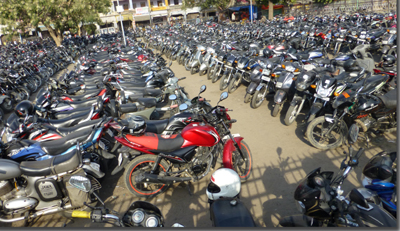 Uden
took John, Bill and me to the railroad station
via tuk tuk. It was a wild
ride, which started by going the wrong way on the street for a block or
two. Bear in mind that you
are mixing with cows, cars, motor scooters, trucks, tour buses, tuk
tuks, the occasional elephant and camel, and pedestrians.
The station had motorcycle commuter lot, which was filled.
Uden
took John, Bill and me to the railroad station
via tuk tuk. It was a wild
ride, which started by going the wrong way on the street for a block or
two. Bear in mind that you
are mixing with cows, cars, motor scooters, trucks, tour buses, tuk
tuks, the occasional elephant and camel, and pedestrians.
The station had motorcycle commuter lot, which was filled.
You will have to bear with me here, for just a bit, as you know I am interested in the railroads.
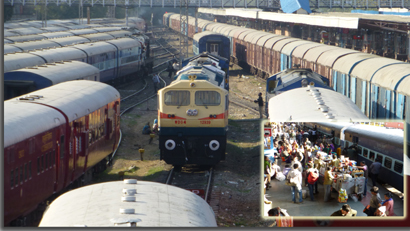 The trains were as expected, looking pretty
humble. The British had laid
around 46,000 km of track, and India laid another 21,000, much of which
is electrified. The trains
here are still a vital transportation source.
It was great, with lots of people, mail, and freight.
I had hoped to see the packed commuter trains with people hanging off
the cars, but that was not to be the case.
The trains were as expected, looking pretty
humble. The British had laid
around 46,000 km of track, and India laid another 21,000, much of which
is electrified. The trains
here are still a vital transportation source.
It was great, with lots of people, mail, and freight.
I had hoped to see the packed commuter trains with people hanging off
the cars, but that was not to be the case.
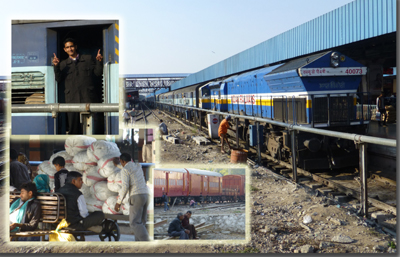 Instead, we timed it just right to watch a
passenger train pull out. It
was long, with only a single engine.
The cars, even the higher end air conditioned sleepers, looked
pretty humble. I’m happy.
Instead, we timed it just right to watch a
passenger train pull out. It
was long, with only a single engine.
The cars, even the higher end air conditioned sleepers, looked
pretty humble. I’m happy.
See the video here.
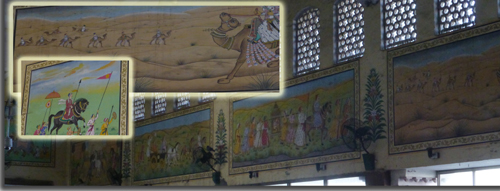 The
train station had some wonderfull murals. You really had to look
to see them, and I'll bet that not one in a hundred people ever looked
up. But they were there.
The
train station had some wonderfull murals. You really had to look
to see them, and I'll bet that not one in a hundred people ever looked
up. But they were there.
 Afterwards, we had dinner at the hotel.
Uden spent some additional time with us, detailing his trekking
jobs and work in the mountains of Nepal.
He has climbed to 21,000 feet, and has guided tourists to that
level. As a Sherpa, he works
with many climbing companies and tourists who come just to trek.
At 33 years of age, he is the youngest of three boys.
He is an interesting man, and has been a delight to travel with.
Afterwards, we had dinner at the hotel.
Uden spent some additional time with us, detailing his trekking
jobs and work in the mountains of Nepal.
He has climbed to 21,000 feet, and has guided tourists to that
level. As a Sherpa, he works
with many climbing companies and tourists who come just to trek.
At 33 years of age, he is the youngest of three boys.
He is an interesting man, and has been a delight to travel with.
India is a land of major contrasts and organized
chaos. From traffic to tax
collection, things seem to just be random acts, but actually serve to
make a whole. This is a very
interesting country. Our
laundry is back and my suitcase is mended.
Life is good.
Today again found us in Jaipur. Or perhaps I should refer to the city as Juniper. You know who you are! And we will be heading for Jupiter. But I digress.
 Our first stop of the day was the Palace of the
Winds. Originally, this was
a palace portion where the women of the court could go and stay hidden
behind lattice screens. They
could watch the world pass by without being seen.
Now, it is just a restored façade.
That does not detract from the beauty of the place.
Our first stop of the day was the Palace of the
Winds. Originally, this was
a palace portion where the women of the court could go and stay hidden
behind lattice screens. They
could watch the world pass by without being seen.
Now, it is just a restored façade.
That does not detract from the beauty of the place.
I should add here the manner in which milk is tested. What appear to be about 6 gallon cans of fresh milk are brought into the city. A man dips his hands in each and rubs his fingers together to test the fat content. So when you order milk in your coffee, that image runs through your head. Hum. Maybe drinking it black is a better choice. Tried to get a picture of this procedure, but it was on the other side of the bus.
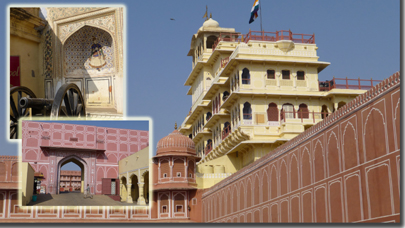 Again we made our way into the new part of
Jaipur, and to the City Palace.
If you will recall from yesterday, part of the deal that was made
when the country was granted independence and unification, was that many
of the grand palaces were turned over to museums trust for preservation.
The City Palace was one such entity.
It is a combination of Rajasthani and Mughal architecture.
It was originally built by Jai Singh and additions continued up
into the 20th century.
A portion of it though, is still the residence of the last
survivors of the Singh family.
Sawai Singh was a noted polo player, and died back in the 70’s.
His widow, daughter and her children now live in the house.
The place is still well kept up, with meeting halls, and several
small museums on the grounds.
Again we made our way into the new part of
Jaipur, and to the City Palace.
If you will recall from yesterday, part of the deal that was made
when the country was granted independence and unification, was that many
of the grand palaces were turned over to museums trust for preservation.
The City Palace was one such entity.
It is a combination of Rajasthani and Mughal architecture.
It was originally built by Jai Singh and additions continued up
into the 20th century.
A portion of it though, is still the residence of the last
survivors of the Singh family.
Sawai Singh was a noted polo player, and died back in the 70’s.
His widow, daughter and her children now live in the house.
The place is still well kept up, with meeting halls, and several
small museums on the grounds.
 Again, one has to marvel at how the life style must have been in
the day of the Raj’s. The
trappings must have been fantastic.
As it was, some of the restored courtyards, doorways and alcoves
were pretty impressive. The
outdoor audience hall had beautiful detail and chandeliers, as well as
the two largest sterling silver pots in the world.
They were used to carry Ganges River water for the Raj when he
traveled.
Again, one has to marvel at how the life style must have been in
the day of the Raj’s. The
trappings must have been fantastic.
As it was, some of the restored courtyards, doorways and alcoves
were pretty impressive. The
outdoor audience hall had beautiful detail and chandeliers, as well as
the two largest sterling silver pots in the world.
They were used to carry Ganges River water for the Raj when he
traveled.
 We were also treated to a turban demonstration.
It turns out the turbans were derived from agricultural head
coverings, and then developed into more of a style statement after the
Afghans mixed into the culture.
Styles differ from region to region. Here, the guard that we
asked about this, pulled off his, which is about 9 meters in length.
He had it wrapped and retied in about a minute.
We were also treated to a turban demonstration.
It turns out the turbans were derived from agricultural head
coverings, and then developed into more of a style statement after the
Afghans mixed into the culture.
Styles differ from region to region. Here, the guard that we
asked about this, pulled off his, which is about 9 meters in length.
He had it wrapped and retied in about a minute.
 Also on site was a planetarium.
This area had many instruments designed to record the sun time,
and to tell astrological signs.
Also on site was a planetarium.
This area had many instruments designed to record the sun time,
and to tell astrological signs.
The inset photo shows a several of the astrological devices which are geared to specific zodiac signs. So their alighnment is in accordance with Pisces, or Leo, or Aquarius. You just pick your sign, and get the reading. Perhaps not the one you want, but at least an "official" reading.
 From there it was time for more shopping, with
some of us going to the Gem Palace, an old world famous jewelry shop.
They actually had a carved train.
I did not ask the price.
And they had a collection of old cars, which interested many of
the men on the trip. And some of
the wall paintings were beautiful. Part of our contingent
went to another textile area, where again, money changed hands.
From there it was time for more shopping, with
some of us going to the Gem Palace, an old world famous jewelry shop.
They actually had a carved train.
I did not ask the price.
And they had a collection of old cars, which interested many of
the men on the trip. And some of
the wall paintings were beautiful. Part of our contingent
went to another textile area, where again, money changed hands.

The latter part of the day was spent relaxing at high tea at the Rambagh Palace Hotel. Wow. What a luxury hotel. The grounds were immaculate and vast, guarded by peacocks.
 Of interest to me, was a restored 0-6-0T BK-4
steam engine and four cars, right on the grounds.
The cars were being used as a restaurant, with immaculate
interiors. The engine had
been restored, complete with gleaming brass fittings in the cab.
It doesn’t go anywhere, but certainly was nifty to look at.
Of interest to the some of the guys, was the 1937 Ford that was
part of the hotel car collection.
We would see car collections at other establishments as well.
Of interest to me, was a restored 0-6-0T BK-4
steam engine and four cars, right on the grounds.
The cars were being used as a restaurant, with immaculate
interiors. The engine had
been restored, complete with gleaming brass fittings in the cab.
It doesn’t go anywhere, but certainly was nifty to look at.
Of interest to the some of the guys, was the 1937 Ford that was
part of the hotel car collection.
We would see car collections at other establishments as well.
We finally made it back to the hotel, where a
nightcap was in order, and then off to bed.
Tomorrow promises to be a slow day.
 Today was a day or relaxation and repacking.
We are half way through the trip, and while some went to a museum
this morning, some of us just chilled.
I used the time to work on my notes, and to redo the luggage.
And that is what we did.
Today was a day or relaxation and repacking.
We are half way through the trip, and while some went to a museum
this morning, some of us just chilled.
I used the time to work on my notes, and to redo the luggage.
And that is what we did.
The only excitement for the afternoon was when a political demonstration went up the street.
Dinner was a lovely affair at the local Oberoi Hotel.
The food was excellent, and the atmosphere was elegant.
Tomorrow we have an early call, so we are all off to bed.
We were locked and loaded by 0800 this morning.
 The
driver had indicated that the road might be iffy, so we left a little
early. After a section of
decent four lane, the road did become a little more primitive.
Read that as it had a lot of holes and speed bumps in it.
The highway combat continued.
It was certainly more intense on the two lane road, as our driver
would pass a string of trucks, while being approached in the opposite
lane by an oncoming string of trucks.
Throw in the occasional cow on the road, along with the
motorcycles, and you had quite a show.
The trucks are all wildly decorated, with bright paint jobs and
flowers attached to the mirrors.
And if you look closely, most have the "Eyes of Buddha" painted under
the front windows.
The
driver had indicated that the road might be iffy, so we left a little
early. After a section of
decent four lane, the road did become a little more primitive.
Read that as it had a lot of holes and speed bumps in it.
The highway combat continued.
It was certainly more intense on the two lane road, as our driver
would pass a string of trucks, while being approached in the opposite
lane by an oncoming string of trucks.
Throw in the occasional cow on the road, along with the
motorcycles, and you had quite a show.
The trucks are all wildly decorated, with bright paint jobs and
flowers attached to the mirrors.
And if you look closely, most have the "Eyes of Buddha" painted under
the front windows.
 Lunch
was at a truck stop (another cousin) and ended up with the local version
of grilled cheese sandwiches, and some potato chip flavors we had never
encountered (grilled tomato). And
there was the usual souvenier stuff to tempt the many shoppers.
The prices here were a tad high, so not much cash traded hands. In
order to reach this little oasis, we didn't follow the usual route of
taking an exit ramp. Ah no. After all, this is India, and
different traffic rules apply. We stopped in the inner most lane,
waited for most oncoming traffic to clear, and then crossed into the
outer opposite lane, and drove the wrong way on the freeway for about a
100 yeards. Getting going again, we crossed over, blocking all
four lanes, and mde our turn. Pretty amazing.
Lunch
was at a truck stop (another cousin) and ended up with the local version
of grilled cheese sandwiches, and some potato chip flavors we had never
encountered (grilled tomato). And
there was the usual souvenier stuff to tempt the many shoppers.
The prices here were a tad high, so not much cash traded hands. In
order to reach this little oasis, we didn't follow the usual route of
taking an exit ramp. Ah no. After all, this is India, and
different traffic rules apply. We stopped in the inner most lane,
waited for most oncoming traffic to clear, and then crossed into the
outer opposite lane, and drove the wrong way on the freeway for about a
100 yeards. Getting going again, we crossed over, blocking all
four lanes, and mde our turn. Pretty amazing.

The terrain changed from flat, to mountainous, and then back to flat farmland again. And I was rewarded with another train. Unfortunately, it was a shot through the trees, but any sighting is better than none.
We arrived in Jodhpur a little earlier than expected, and are settled in a lovely room at the Ajit Bhawan Hotel. What a delightful place. Right next door a Hindu wedding was being held. Barb got over just in time to see the groom ride in on a horse, which is a tradition. See a clip here. There were loads of flowers and plenty of food and drink. I walked over later, and the bride and groom had not yet made an appearance. They have to wait for the astrologically appropriate time to appear together and perform the final ceremony. One of our guides told us that when he got married, his mother-in-law to be insisted on a good astrology reading. His first attempt to obtain such a reading didn’t work out so well, so he basically bribed the astrologer to give him a good result. He has been happily married for some years, with a couple of kids, and finally admitted to his mother-in-law what he had done. She is now not quite as keen on astrology!
 Dinner
was at the hotel, the Ajit Bhawan Palace. Our rooms were small
individual structures and there were lots of little hide-away relaxation
areas all over the grounds. The restaurant was outdoors, as it was
set up in a courtyard. There were fires for warmth, and torches for light.
Speaking of the hotel, the place was originally a royal residence
for a prince of Rajasthan.
After the deal in 1970, rooms were added, and the place was turned into
a hotel. It is quite the
deal. Note the insert of the door
lock. We would encounter this form of locking during the rest of
our trip. No key cards here. It is kind of a pain, to be
frank, but it is quaint.
Dinner
was at the hotel, the Ajit Bhawan Palace. Our rooms were small
individual structures and there were lots of little hide-away relaxation
areas all over the grounds. The restaurant was outdoors, as it was
set up in a courtyard. There were fires for warmth, and torches for light.
Speaking of the hotel, the place was originally a royal residence
for a prince of Rajasthan.
After the deal in 1970, rooms were added, and the place was turned into
a hotel. It is quite the
deal. Note the insert of the door
lock. We would encounter this form of locking during the rest of
our trip. No key cards here. It is kind of a pain, to be
frank, but it is quaint.
We all headed for bed and for me, the sounds of
train horns were a bonus.
 Welcome to Jodhpur, the Blue City.
Why Blue? I’ll tell
you in just a moment. We
hooked up with our city guy, Pommy, and he gave us the scoop on why it
is known as the Blue City. Jodhpur
was once the center of Marwar, one of Rajasthan's largest princely
states, and a fierce rival of the feudal states of Jaipur and Udaipur.
It was founded by Rao Jodha in 1459. So why Blue? Considered to be the cultural center of Rahjastan, the houses were
painted blue by the Brahmin caste who settled here.
They were the only ones allowed to do so until 1947.
The houses are painted twice a year, and serve to repel the
summer sun, and simultaneously repel the mosquitoes, as the blue paint
contains copper sulfate.
Welcome to Jodhpur, the Blue City.
Why Blue? I’ll tell
you in just a moment. We
hooked up with our city guy, Pommy, and he gave us the scoop on why it
is known as the Blue City. Jodhpur
was once the center of Marwar, one of Rajasthan's largest princely
states, and a fierce rival of the feudal states of Jaipur and Udaipur.
It was founded by Rao Jodha in 1459. So why Blue? Considered to be the cultural center of Rahjastan, the houses were
painted blue by the Brahmin caste who settled here.
They were the only ones allowed to do so until 1947.
The houses are painted twice a year, and serve to repel the
summer sun, and simultaneously repel the mosquitoes, as the blue paint
contains copper sulfate.

First stop was a mausoleum, the Jaswant Thada. It was built as a memorial to the Maharaja, and was visible from the Mehrangarh Fort. The mausoleum was a great example of Indian architecture, with white marble and carved stone latticework. The grounds were beautiful, with a small lake just below the temple.
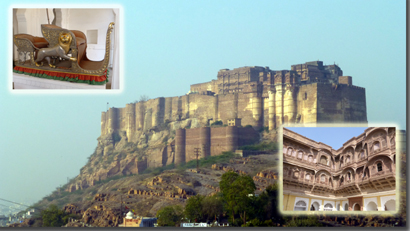 Situated on top of a large chunk of stone, the
Mehrangarh Fort was an amazing piece of work.
Started in the 16th century, the place was still being
added on to in the 1950s.
The amount of labor that went into this place was simply staggering.
And there was a wall that went around the entire town as a part
of the place. Upkeep must
have been ferocious. When
Indira Ghandi came to power and stripped the royalty of a lot of their
property (or at least didn’t give them any special breaks any more), the
family put the place in trust.
Proceeds from tours now go to upkeep on the place.
Situated on top of a large chunk of stone, the
Mehrangarh Fort was an amazing piece of work.
Started in the 16th century, the place was still being
added on to in the 1950s.
The amount of labor that went into this place was simply staggering.
And there was a wall that went around the entire town as a part
of the place. Upkeep must
have been ferocious. When
Indira Ghandi came to power and stripped the royalty of a lot of their
property (or at least didn’t give them any special breaks any more), the
family put the place in trust.
Proceeds from tours now go to upkeep on the place.

There was a Sufi Music Festival going on this weekend, and today was the last day. So we go to listen to some folk music, have a cup of masala tea, and just relax.
Listen to the music here.
 Fortunately,
there is an elevator which takes you up 12 stories to the main
courtyards. From there, it
is pretty much a museum, with elephant howdas, silk paintings,
pallaquins and other items from the fort’s glory years.
We had another turban demonstration, and it was easy to see how
this style differed from the one in Jaipur (no tail).
The views from the top are spectacular, and you could really see
the Blue City.
Fortunately,
there is an elevator which takes you up 12 stories to the main
courtyards. From there, it
is pretty much a museum, with elephant howdas, silk paintings,
pallaquins and other items from the fort’s glory years.
We had another turban demonstration, and it was easy to see how
this style differed from the one in Jaipur (no tail).
The views from the top are spectacular, and you could really see
the Blue City.
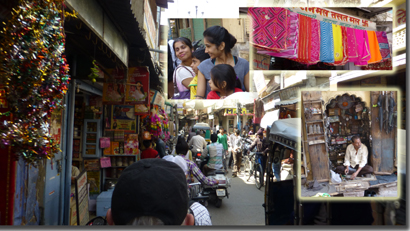 From there we descended into the market.
Wow. The sounds, the
sights and the colors are all really amazing.
Little shop fronts, narrow alleys and loads of people are all
intermixed with motorcycles, the occasional tuk tuk, and once in a while
a cow or two. The fabrics
are colorful, which makes the saris look smashing.
People were friendly, and smiling.
Most everyone then went back to the hotel.
From there we descended into the market.
Wow. The sounds, the
sights and the colors are all really amazing.
Little shop fronts, narrow alleys and loads of people are all
intermixed with motorcycles, the occasional tuk tuk, and once in a while
a cow or two. The fabrics
are colorful, which makes the saris look smashing.
People were friendly, and smiling.
Most everyone then went back to the hotel.
 John, Uden and I went back to the market to see
the Sardar Market Girdikot Clock Tower.
Work started on March of 1910, and two years later it was
complete. We had a bite to
eat in a rooftop restaurant.
John, Uden and I went back to the market to see
the Sardar Market Girdikot Clock Tower.
Work started on March of 1910, and two years later it was
complete. We had a bite to
eat in a rooftop restaurant.
Listen to the traffic and see the sights here.

The views from the top show the market, as well as the looming fort.
The ride back to the hotel via tuk tuk was the usual wild ride, and involved going the wrong way down the street for the last few blocks. No one seems to think anything about this. Other vehicles and people just get out of your way.

On the way back in, we took a quick look at the hotel car collection. Most are from 1947/48 and are actually a nice collection of right hand drive American cars. I had the doorman pose for a quick shot.
Dinner will be at the hotel tonight.
Tomorrow we leave.
One of the things that I have forgotten to mention is the fact that it is considered good luck to feed a cow some alfalfa in the morning. Along the road you will find people selling alfalfa bundles just for such use. Also, when a woman is cooking, the first piece of naan bread goes to the cow, and the last to the dog.
 But
on with today. This morning
we started at the sensible hour of 9 AM.
Six of us opted for a jeep ride through some smaller towns.
The plan was to meet the bus later in the morning, down the road.
So we made our way through the outskirts of the city, past loaded
grain trucks, people cutting stone with huge saws, and schools.
But
on with today. This morning
we started at the sensible hour of 9 AM.
Six of us opted for a jeep ride through some smaller towns.
The plan was to meet the bus later in the morning, down the road.
So we made our way through the outskirts of the city, past loaded
grain trucks, people cutting stone with huge saws, and schools.
 Our
first stop was at a potter’s studio.
He demonstrated throwing pots, and of course, offered us the
opportunity to purchase his work.
It really was interesting to watch him fire up a stone wheel,
which was stick driven. The
wheel was on a pivit point, and he just used a stick to get it spinning.
He was able to throw three pots in just a few minutes.
His kiln was a big, open air firepit.
Our
first stop was at a potter’s studio.
He demonstrated throwing pots, and of course, offered us the
opportunity to purchase his work.
It really was interesting to watch him fire up a stone wheel,
which was stick driven. The
wheel was on a pivit point, and he just used a stick to get it spinning.
He was able to throw three pots in just a few minutes.
His kiln was a big, open air firepit.

Everywhere we were warmly greeted, and the family and the kids were shown off. While the younger children weren't thrilled, it was fun for us to see families.
 Our
second stop was perhaps the most interesting.
It was here that we were shown how opium is made, and consumed.
It is perfectly legal to use it in the homes as a drink, and as a
balm when working in the fields.
People only use it every other day, so as not to become addicted.
Truthfully, several of us tried a small grain of the stuff.
It sort of tasted like rock candy, but bitter with a hint of
sweetness that came from the sugar that was mixed with the sap.
OK, that was kind of weird.
We were not offered the opportunity to purchase.
It is illegal for the family to sell the product.
It is solely for their personal consumption.
The man said the women use it a lot when they are working in the
fields.
Our
second stop was perhaps the most interesting.
It was here that we were shown how opium is made, and consumed.
It is perfectly legal to use it in the homes as a drink, and as a
balm when working in the fields.
People only use it every other day, so as not to become addicted.
Truthfully, several of us tried a small grain of the stuff.
It sort of tasted like rock candy, but bitter with a hint of
sweetness that came from the sugar that was mixed with the sap.
OK, that was kind of weird.
We were not offered the opportunity to purchase.
It is illegal for the family to sell the product.
It is solely for their personal consumption.
The man said the women use it a lot when they are working in the
fields.

The final stop was the usual rug weaving place. These guys had solar panels and a Visa machine. So once again, any trade imbalance between the USA and India was softened.

I got to see a freight train, so life was good. Note the small transfer caboose. The engines are rather brutish affairs, with what appears to be a lot of horsepower. Note the long C style trucks.

On the way to the bus, we saw several antelope, as well as the largest land animal in Asia, a Blue Bull, better known as a Nilgai. There were also a few antelope or gazelles.
The bus ride was long, and bumpy, as we went through great deal of road construction. The roads are being improved to four lane, although with toll gates.
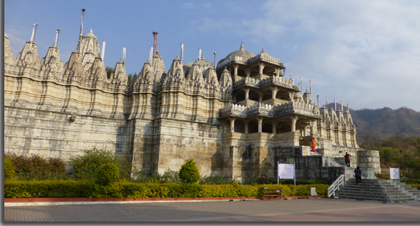 Our
final stop of the day was to the Ranakpur Jain Temple.
An offshoot of Hinduism, the religion is the smallest, yet most
affluent of the all the religions here in India.
I believe that we were told that they have a membership of only
about 8 million.
Our
final stop of the day was to the Ranakpur Jain Temple.
An offshoot of Hinduism, the religion is the smallest, yet most
affluent of the all the religions here in India.
I believe that we were told that they have a membership of only
about 8 million.
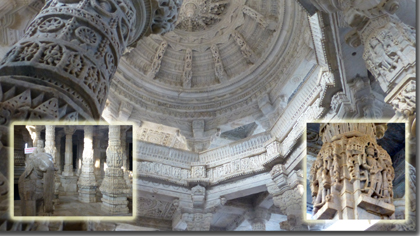 The
temple was large, and ornately carved, with multiple pillars, and a
distinctive look to the domes.
Started in the 1500’s the temple is so constructed so that none
of the pillars obstruct the view of the center idol.
The
temple was large, and ornately carved, with multiple pillars, and a
distinctive look to the domes.
Started in the 1500’s the temple is so constructed so that none
of the pillars obstruct the view of the center idol.

As I said, the carvings and stone work was pretty amazing. No matter where you looked, there was some intricately carved pillar, or support bean or just wall decoration.
 From
there, it was short trip to the Hotel Fateh Bagh Palace here in Ranakpur.
Like the last place, it looks like a palace, with nice rooms.
But everything is so dark.
Of course, tourists that we are, we had to have our photo op with the
doorman.
From
there, it was short trip to the Hotel Fateh Bagh Palace here in Ranakpur.
Like the last place, it looks like a palace, with nice rooms.
But everything is so dark.
Of course, tourists that we are, we had to have our photo op with the
doorman.
We are off to hook up with Sharon and Ken, and see if they saw tigers on their separate trip. They had hired a car and took a side trip to Ranthambore National Park. Later. No tigers were spotted, but they did see paw prints. So I guess that counts.
Dinner was at the hotel, and we seem to be the
only people here. This area
is a resort area for Indians, and I think we are way out of season.
It was a lovely place, though, with an attentive staff.
The beds were very hard.
Tomorrow is another day.
 We
were out of the hotel at a reasonable hour.
We headed down a whole lot of bad road toward our next stop, the
largest fort in Rajasthan.
The terrain has changed, and become quite mountainous.
There were loads of monkeys along the way, and we continued to
see oxen or water buffalo driven well pumps.
We
were out of the hotel at a reasonable hour.
We headed down a whole lot of bad road toward our next stop, the
largest fort in Rajasthan.
The terrain has changed, and become quite mountainous.
There were loads of monkeys along the way, and we continued to
see oxen or water buffalo driven well pumps.
 Along
the way we stopped for a brief visit to a school, and ended up pretty
much disrupting the whole school day.
These kids were in grades 1-4, and we of course, all took photos,
and made introductions. You
have to wonder if they find us as exotic as we seem to find them.
This was a rural area, and the difference in lifestyle and
culture between the two groups (rural and city) seems to me to be
immense.
Along
the way we stopped for a brief visit to a school, and ended up pretty
much disrupting the whole school day.
These kids were in grades 1-4, and we of course, all took photos,
and made introductions. You
have to wonder if they find us as exotic as we seem to find them.
This was a rural area, and the difference in lifestyle and
culture between the two groups (rural and city) seems to me to be
immense.
 Around
Noon, we reached the Kumbal Garh Fort.
This is the largest fort in Rajasthan, and with a wall length of
around 36 km, the second longest wall next to the Great Wall of China.
The place was built in the 15th century, and was a
only conquered by the Mughals after three women let some of the invaders
in to poison the water supply.
The women themselves were either later poisoned themselves or
were buried alive. Stories
vary.
Around
Noon, we reached the Kumbal Garh Fort.
This is the largest fort in Rajasthan, and with a wall length of
around 36 km, the second longest wall next to the Great Wall of China.
The place was built in the 15th century, and was a
only conquered by the Mughals after three women let some of the invaders
in to poison the water supply.
The women themselves were either later poisoned themselves or
were buried alive. Stories
vary.
 19th
century. At 3300 meters in
altitude, the place does disappear into the clouds.
The walk up was strenuous, but the views were magnificent, with
mountains, small villages, and of course, the 6 meter width wall.
19th
century. At 3300 meters in
altitude, the place does disappear into the clouds.
The walk up was strenuous, but the views were magnificent, with
mountains, small villages, and of course, the 6 meter width wall.
After a lunch, which included Pringles (yea!) we used up more bad road until hitting a good four lane highway for the final run into Udaipur.
 I
should also take the time to mention our two, absolutely fabulous drive
and his assistant. I did not have the foresight to obtain last
names. However, oue main driver is the turbaned Mr. Maghrit.
And his assistent, driver in training and all around nice guy, was Ravi.
Both were great fun to be with, and they performed and astounding job.
A tip of the hat to you both!
I
should also take the time to mention our two, absolutely fabulous drive
and his assistant. I did not have the foresight to obtain last
names. However, oue main driver is the turbaned Mr. Maghrit.
And his assistent, driver in training and all around nice guy, was Ravi.
Both were great fun to be with, and they performed and astounding job.
A tip of the hat to you both!
 This
town of around 600,000 people is a resort area, and loaded with hotels.
Also to be found here is the Island Palace Hotel, which is
pictured in all the books on India.
We are supposed to go see it tomorrow.
But for the moment, we are in the Oberoi Udaivilas, which is
simply fabulous. In fact, we
were greeted by fluttering rose petals that fell from the sky as we
walked into the hotel. Wow.
I have never had that kind of an entrance before.
And the service is pretty high end.
I think there were two guys to deliver the bags, all while the
man who walked us to the room was showing us how everything worked.
Like I’ve said before, I could get used to this.
This
town of around 600,000 people is a resort area, and loaded with hotels.
Also to be found here is the Island Palace Hotel, which is
pictured in all the books on India.
We are supposed to go see it tomorrow.
But for the moment, we are in the Oberoi Udaivilas, which is
simply fabulous. In fact, we
were greeted by fluttering rose petals that fell from the sky as we
walked into the hotel. Wow.
I have never had that kind of an entrance before.
And the service is pretty high end.
I think there were two guys to deliver the bags, all while the
man who walked us to the room was showing us how everything worked.
Like I’ve said before, I could get used to this.
After the usual evening meeting in the bar,
dinner was served on the terrace.
The sparkling lights on the lake, the lighted topiary and the
grounds of the hotel made for a magical evening.
I had a rather rough night last night, so today will remain a quiet day. Or at least one with little food. Despite it all, we were out at the relatedly sane hour of 0930 to meet out city guide.
 Before
we go, though, I must say that this hotel is lovely.
At a room rack rate of around US$660 per night, I guess it should
be. The grounds keepers were
even sweeping the grass! I
told Barb not to get any ideas.
The marble and décor just makes this place a modern day palace.
But onward.
Before
we go, though, I must say that this hotel is lovely.
At a room rack rate of around US$660 per night, I guess it should
be. The grounds keepers were
even sweeping the grass! I
told Barb not to get any ideas.
The marble and décor just makes this place a modern day palace.
But onward.
This region is part of the Mewar Region of Rajasthan. The last monarch, Maharana Bhagwat Singh passed away on 2 November 1984. He had 2 sons; the elder Mahendra singh and younger Arvind Singh. Both look after the Maharana Mewar Foundation (remember the practive of putting roykal palaces in trust?). The current monarch – another guy with Singh in his name - actually Arvind singh - still lives in a portion of this City Palace.
 The
real name is Pateh Prakesh Palace, and it is right on the shores of Lake
Pichola. In fact, his former
summer residence is now the famous Lake Palace Hotel, which appears to
float right in the middle of the lake.
The palace, again a museum and in trust, available for weddings,
corporate gatherings, etc., was the usual affair.
There were lots of steps, lots of plaster and marble, and lots of
tourists. So we saw the
usual courtyards, living chambers, and beautiful restored reliefs and
glass frescos. In fact,
while all these forts/palaces are sort of the same, they are all
different in their own way.
The
real name is Pateh Prakesh Palace, and it is right on the shores of Lake
Pichola. In fact, his former
summer residence is now the famous Lake Palace Hotel, which appears to
float right in the middle of the lake.
The palace, again a museum and in trust, available for weddings,
corporate gatherings, etc., was the usual affair.
There were lots of steps, lots of plaster and marble, and lots of
tourists. So we saw the
usual courtyards, living chambers, and beautiful restored reliefs and
glass frescos. In fact,
while all these forts/palaces are sort of the same, they are all
different in their own way.

What is astounding is the amount of man hours and work that went into construction. In some cases, just getting materials to the work site was a major endeavor.

Before I forget, there are four castes in India; the Brahmans (scholars & priests), Kshatriyas (warriors, rulers and large landowners), Vaisyas (businessmen, traders & artisits), and the Sudras (usually peasants). Below all of them is a group excluded from social and religious privileges of Hinduism, the untouchables.
We had a ride on the lake, and floated past the local ghats, where people were bathing and doing laundry. Of course we went past the palace, and the former homes of nobles, which are now hotels. We ended up at another lake island park, which is available for rentals.
 We
cruised around the Lake Palace Hotel, which is in all the books about
India. But it perhaps better known for it's having been a location
in the James Bond film "Octopussy." Built entirely on an island as
a summer palace, it is spectacular.
We
cruised around the Lake Palace Hotel, which is in all the books about
India. But it perhaps better known for it's having been a location
in the James Bond film "Octopussy." Built entirely on an island as
a summer palace, it is spectacular.
We had lunch at the Aroma Restaurant, and then, instead of the planned visit to a botanical garden (the guide said our hotel grounds were better), we visited a car museum.
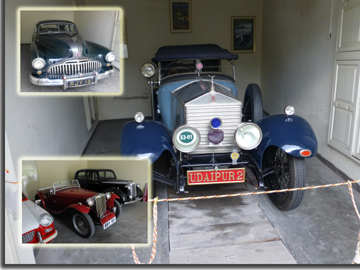 They
had a small stock of Mercedes Benz, Rolls Royce, and other British cars,
like Triumphs, Vauxhalls, and the like.
This is not the first right hand drive late 1940s Buick I have seen.
These cars seem to have been a big hit.
They
had a small stock of Mercedes Benz, Rolls Royce, and other British cars,
like Triumphs, Vauxhalls, and the like.
This is not the first right hand drive late 1940s Buick I have seen.
These cars seem to have been a big hit.
 Then
back to the hotel, through the crowded traffic, which was made more so,
by some sort of women’s demonstration, and a wedding.
There are so many sights that I can only capture a few of them
here. Dinner is again at the
hotel.
Then
back to the hotel, through the crowded traffic, which was made more so,
by some sort of women’s demonstration, and a wedding.
There are so many sights that I can only capture a few of them
here. Dinner is again at the
hotel.
 This
was a quiet day. I’m still
not feeling quite up to par, so while the others went exploring, Barb
and I just enjoyed the luxury of the Oberoi Udaivilas.
And what luxury it is.
Shooting on the film "The Best Marigold Hotel 2" is going on here in
Udaipur. Judy Dench (there were sightings) and Penelope
Wilton, the woman who plays Mrs. Crowley on "Downton Abbey", Maggie
Smith, and Dev Patel are staying
here.
This
was a quiet day. I’m still
not feeling quite up to par, so while the others went exploring, Barb
and I just enjoyed the luxury of the Oberoi Udaivilas.
And what luxury it is.
Shooting on the film "The Best Marigold Hotel 2" is going on here in
Udaipur. Judy Dench (there were sightings) and Penelope
Wilton, the woman who plays Mrs. Crowley on "Downton Abbey", Maggie
Smith, and Dev Patel are staying
here.
We wanted to see the animals being fed around 11 AM, and while we waited patiently, the animals were a no show.
We repacked, and generally just chilled in opulence and walked around the 26 acre grounds complete with a chip and put golf course. It is hard to believe the chaos that exists just a few blocks away, outside the complex. The view from our personal patio was so relaxing.
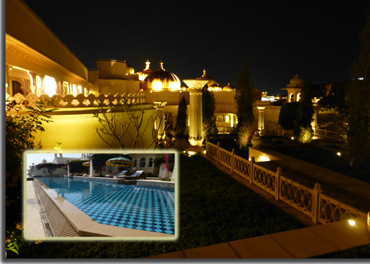 Tonight
is our farewell dinner, as tomorrow, we head back to Dehli.
Half of the group will head back to the USA, while the other half
are on the Nepal.
Tonight
is our farewell dinner, as tomorrow, we head back to Dehli.
Half of the group will head back to the USA, while the other half
are on the Nepal.
India has been exciting.
It is a kaleidoscope of colors, events, sights and sounds.
It is high, and low, and everything in between.
You can go from seeing a man urinating against a wall, while a
woman in a beautiful sari walks past, to cows in the middle of the
street, to a luxury oasis with five star service.
And over all, people are smiling, helpful and as interested in us
as we are in them. My
preconceived notion of INDIA standing for “I’ll Never Do India Again”
was totally incorrect. I
would not have missed this.
We are both so glad we came.
Today was another slow day, which started with a relaxing morning at the hotel. It as great to just sit again on our private patio and listen to the birds and watch the wind rustle the leaves.
All too soon it was time to depart for the
airport. It was tough
leaving the Oberoi property, but all good things must come to an end.
So we traded in the serenity of the hotel for the relative
madness of the airport.
Truthfully, we were so early, that things really weren’t too bad.
We had about an hour flight back up to Delhi, and are back in the
Claridges Hotel. There is a
wedding going on, so things may become noisy.
We all had a sandwich and a drink in the bar, and those of us
that were heading to Nepal said good-bye to those that were headed home.
We actually got to stay in the hotel until 0800, and then were headed back to the Delhi airport.
The flight up to Kathmandu was on Indigo Airlines, a low cost, no frills carrier. They even wanted me to pay for coffee! And the seats were really crammed together. People on the flight behavied with less courtesy than we have been used to for the last three weeks. I had to body slam a couple of people just to get off the plane.
The Kathmandu airport was – well, rustic. And it started to rain. And this wasn’t just a little drizzle, this was RAIN. Nevertheless, our guide met us, and took us to a charming city hotel, located only minutes from the airport.
 Dwarika’s
Resort was a result of the founder, one Dwarika Das Shrestha, deciding
to save his cultural heritage.
He started saving artifacts, and to store them, decided to
construct a building in an ancient style, to give all the pieces a new
lease on life. That turned
into the hotel created as a living museum.
Dwarika’s
Resort was a result of the founder, one Dwarika Das Shrestha, deciding
to save his cultural heritage.
He started saving artifacts, and to store them, decided to
construct a building in an ancient style, to give all the pieces a new
lease on life. That turned
into the hotel created as a living museum.
Due to the rain, we bagged the two tours slated
for today, and chilled. To
give you an idea how we feel, we all had steak sandwiches for lunch and
voted them, really, really fine.
Dinner will probably be in the bar.
I need money. I can’t
get Indian Rupees converted, as they won’t take 500 denomination notes.
I guess an ATM is in order once again.
Today dawned partially cloudy, and the forecast is for sun in the morning, with rain in the afternoon. So we revised our itinerary yet again with our city guide, one Pratik Manandhar. He seems like an affable fellow, and has a pretty good command of the English language.
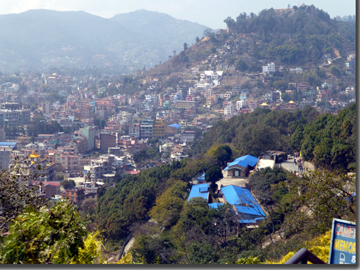 Kathmandu,
the capitol of Nepal, has a population of around 2.8 million people,
which is roughly 10% of the total country (28 million).
There are three regions: the mountains, the highlands (where we
are now) and the lowlands, which are primarily agricultural.
Kathmandu,
the capitol of Nepal, has a population of around 2.8 million people,
which is roughly 10% of the total country (28 million).
There are three regions: the mountains, the highlands (where we
are now) and the lowlands, which are primarily agricultural.
 My
early impressions are that the place is a little beat up.
While things are similar to India, things look to be a little
more untidy and beat up. Wiring
is a nightmare, and appears even worse than India electrical systems.
The people are definitely pushier than they were in India.
I’ve had to body block a few just to get through a doorway.
And the street hawkers are much more aggressive and annoying than
in India.
My
early impressions are that the place is a little beat up.
While things are similar to India, things look to be a little
more untidy and beat up. Wiring
is a nightmare, and appears even worse than India electrical systems.
The people are definitely pushier than they were in India.
I’ve had to body block a few just to get through a doorway.
And the street hawkers are much more aggressive and annoying than
in India.

We started off the day by driving past a load of little shops on the way to Durbar Square in Kathmandu City. This square has the Temple of the Living Goddess, one Kumali. She is a young girl, picked from the same area as Buddhas birthplace and kept in splendor as an embodiment of the living Goddess until adolescence. We were not allowed to take photos, but she appeared to look just like any bored eight year old.

The carvings on the temples are all pretty fantastic, and while in India there was a lot of sandstone, marble and stonework, here it is all wood. I guess you go with what you have.
 The
entrance to the Royal Palace was guarded by lion statues, and
intricately carved reliefs. The doors are also carved.
The
entrance to the Royal Palace was guarded by lion statues, and
intricately carved reliefs. The doors are also carved.
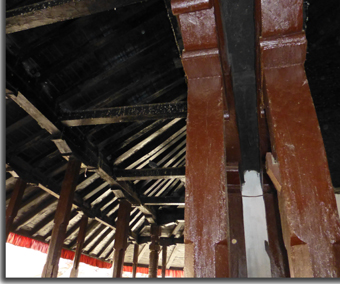
A stop in the Square was Kasthamandap, a monument built from the truck of a single tree, and from which the name of the city was derived.
 Everywhere
you looked there were shrines, carvings, people and pigeons.
It is considered good luck to feed the pigeons, so there are
swarms of them. The palace is also
guarded by a statue of the Monkey God, who, looks a bit like Homer
Simpson.
Everywhere
you looked there were shrines, carvings, people and pigeons.
It is considered good luck to feed the pigeons, so there are
swarms of them. The palace is also
guarded by a statue of the Monkey God, who, looks a bit like Homer
Simpson.
There was some chanting going on. To see and hear it, click here.
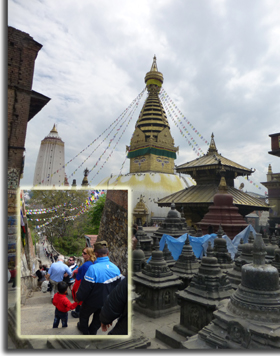 Next
stop was Swayambhunath, the Temple of the Monkey God.
Situated high on a high overlooking the city, there are 365 steps
to the top. Wasn’t going to
happen. Fortunately, we could
drive almost to the top. It was
still a bit of a climb, but we made it, huffing a bit from the altitude
(about 4500 feet). Yeah, that’s
the reason.
Note the Eyes of Buddha,
and what looks like a nose/mouth actually is a symbol meaning we are all
one.
Next
stop was Swayambhunath, the Temple of the Monkey God.
Situated high on a high overlooking the city, there are 365 steps
to the top. Wasn’t going to
happen. Fortunately, we could
drive almost to the top. It was
still a bit of a climb, but we made it, huffing a bit from the altitude
(about 4500 feet). Yeah, that’s
the reason.
Note the Eyes of Buddha,
and what looks like a nose/mouth actually is a symbol meaning we are all
one.
The top has some amazing temples, as well as every tourist trinket known to mankind. This Buddhist Stupa overlooks the Kathmandu Valley.

And of course, there are the monkeys. Much of the place seemed pretty filthy, what with the loads of pigeon and monkey droppings. But the insides of the tourist shops were immaculate. We left some cash and departed, on our way to neighboring Patan City.
Mr. Pratik informed us along the way that the big issues facing the city are overcrowding, and a drain on resources, including electricity, which we have noticed as the power in the hotel drops periodically. Water is also an issue.
Traffic is the usual mess, with narrow streets and way to many vehicles, but much less horn honking than in India.
 The
Patan Durbar Square is full of shrines and temple palaces.
Again, a lot of carvings were in abundance.
The square has three main chowks or courtyards.
Included in one is the stone bath.
Again, no photos were allowed, so I had to settle for people
photos.
The
Patan Durbar Square is full of shrines and temple palaces.
Again, a lot of carvings were in abundance.
The square has three main chowks or courtyards.
Included in one is the stone bath.
Again, no photos were allowed, so I had to settle for people
photos.
We had lunch at the Patan Museum Café. From there, it was back to the hotel, for a nap. The hotel is pretty amazing as it is a whole series of buildings built around a courtyard. While it is a bit chilly for the pool, there are plenty of other amenities to occupy the visitors time. Dinner was at the hotel's Nepalize restaurant. Both John and I are feeling a little iffy, so we shall see how it goes. Plus, if they wanted fancy dress, we aren’t going to fit in. Later. Dinner was a load of fun. There were several options for the number of courses, We were treated to the seven course meal. This included appretizers, soups, mains, desserts, and three others, that frankly escape my memory. I do remember that we had plenty of wine, we had an abundance of food, and we had to practically sit on the floor. So there was a lot of posture shifting going on. While some of the food was delicious, some of it just sort of got rearranged on the plate. Still , it was a good time, and definitely a meal to remember. Oh! There was a 21 course option. I can't imagine....
We pulled out of the hotel this morning and left Kathmandu City for a place about 30 kilometers out into the country. Initially, it was a bit hazy, but the weather cleared as we passed through rural villages and climbed higher.
 It was interesting to see the pace of life, and
to see the neatly tended fields of cabbage, rice and wheat.
The fields were green, the sky was blue. What more can I say.
It was interesting to see the pace of life, and
to see the neatly tended fields of cabbage, rice and wheat.
The fields were green, the sky was blue. What more can I say.
 One
thing we all found fascinating was the use of powered
cultivators used as motive power to haul trailers for people or goods.
I guess, why not?
One
thing we all found fascinating was the use of powered
cultivators used as motive power to haul trailers for people or goods.
I guess, why not?
 As
in the city, the houses are all tall and narrow.
Apparently the land plots are small and that is one way to pack
in a lot of floor space.
There is the usual approach of having your shop on the ground floor, but
there were a bunch of stand alone homes as well.
As usual, cattle and livestock just sort of run around.
There is a lot of terracing, as the hills can be steep.
As
in the city, the houses are all tall and narrow.
Apparently the land plots are small and that is one way to pack
in a lot of floor space.
There is the usual approach of having your shop on the ground floor, but
there were a bunch of stand alone homes as well.
As usual, cattle and livestock just sort of run around.
There is a lot of terracing, as the hills can be steep.
 There are lots and lots of bricks. The valley is dotted with brick
factories that add to the pollution, and everywhere one sees piles of them, ready for shipment.
There are lots and lots of bricks. The valley is dotted with brick
factories that add to the pollution, and everywhere one sees piles of them, ready for shipment.
The most annoying thing about the traffic is the motorbikes. They are everywhere – on the streets, on the walkways, in the alleys. They are just a pain in the butt. Unlike India, there are more women driving them. And except for the bikes, horn blowing is at a minimum. That doesn’t mean traffic is light. Far from it. And the roads rules are about like what we have seen for the last three weeks. I digress.
 Our journey took us up a self named “Highway to
the Clouds.” This was a
steep, winding, single lane, mostly paved road that just kept ascending
into the hills. There were
no guard rails, so Barb was a bit freaked, as she has memories of the
Mexican no brake situation some years back.
Our journey took us up a self named “Highway to
the Clouds.” This was a
steep, winding, single lane, mostly paved road that just kept ascending
into the hills. There were
no guard rails, so Barb was a bit freaked, as she has memories of the
Mexican no brake situation some years back.
 The vistas were spectacular, with terraced plantings, farm
compounds, kids on their way to school, and loads of bricks.
The clay soil is conducive to loads of brickmaking.
The vistas were spectacular, with terraced plantings, farm
compounds, kids on their way to school, and loads of bricks.
The clay soil is conducive to loads of brickmaking.
Farm land eventually gave way to bamboo forests, and we saw some guys carrying extremely long pieces which would be used in building construction. The bamboo gave way to pine forest, and then we got to Nagarkot, sort of the top of the hill for the road. But not for us.
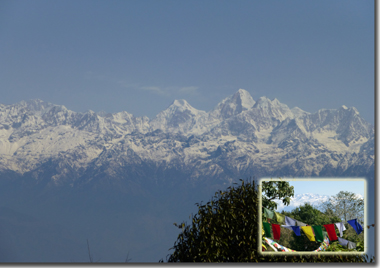 At an altitude of around 2200 meters (6500 ft,
we huffed and puffed our way up a very broken staircase to see the
Himalayas. The mist was
gone, and while Everest was behind a cloud, it was a spectacular vista.
And there was a guy at the top selling photo magnets.
We all had more Christmas card photos taken, and then huffed our
way down to the van for the return trip to Bhaktapur City.
At an altitude of around 2200 meters (6500 ft,
we huffed and puffed our way up a very broken staircase to see the
Himalayas. The mist was
gone, and while Everest was behind a cloud, it was a spectacular vista.
And there was a guy at the top selling photo magnets.
We all had more Christmas card photos taken, and then huffed our
way down to the van for the return trip to Bhaktapur City.

As you can see, "We Were There." Top of the world, or at least as close as I am going to get. I never thought that I'd get to see the Himalaya Range in person.
See the mountains here.
 Bhaktapur
City is the Kathmandu Valley’s most medieval
city and was one of the three kingdoms in the area.
Bhaktapur
City is the Kathmandu Valley’s most medieval
city and was one of the three kingdoms in the area.
 We saw the traditional Lion Gate, as well as the Palace of 55
Windows (I didn’t count them) and the Golden Gate.
The carved beams and windows were worth examining.
We saw the traditional Lion Gate, as well as the Palace of 55
Windows (I didn’t count them) and the Golden Gate.
The carved beams and windows were worth examining.

The royal bath was huge, and certainly didn’t look particularly appealing.
We dallied a bit in the gift shop area, and ended up in a Mandala Art Studio. We got the tourist demonstration on the difference between the Buddhist Stages, the Circle of Life, and something else I don’t remember. I do remember that they took Visa.

Barb took an opportunity to visit some animals on some temple steps. Honestly, I can't remember the significance of the place, other than it was a good place to sit.
Next on the list was a long ride through traffic to the Narayan Hiti Palace Museum. This was the royal palace until the Royal Massacre of 2001. The Palace itself is now a museum, but the place where the killings took place was demolished. Story has it that the crown prince was denied permission to marry the one he loved, so he killed the family, and then himself. Of course, there is a counter conspiracy theory.
The Palace was but in the 1960s, and has a 60ish look, with a bit of an odd design. The interior is filled with animal skins, juxtaposed with tube type TVs, and 1960 deco furniture. And the chandeliers were something else. There were no photos allowed, so you’ll have to take my word for it.
Back in the bus, we passed long ques of motorbikes and cars lined up for fuel. Apparently just like the power, there is a shortage of fuel. So people are always eager to stay topped off.
And then we headed for the Thamel Market, which was a maze of narrow streets and alleys, populated by every trinket shop known to mankind – the ever more annoying motorbikes. And the wiring is again a thing to ponder.
 But we didn’t stop to shop.
Nope. We cruised the
place by – bicycle rickshaw.
These things could use some serious repair, as the chains kept slipping
off. It was bumping, and
uncomfortable, but hilarious.
We did all sort of feel sorry for the guys working the pedals, as
we are a bunch of big Americans.
Note the inset photo of Barb.
Does she look like she is having a good time?
But we didn’t stop to shop.
Nope. We cruised the
place by – bicycle rickshaw.
These things could use some serious repair, as the chains kept slipping
off. It was bumping, and
uncomfortable, but hilarious.
We did all sort of feel sorry for the guys working the pedals, as
we are a bunch of big Americans.
Note the inset photo of Barb.
Does she look like she is having a good time?
All in all, it was quite an experience, and one to be coupled with the Indian tuk tuk rides. Once that was done, we headed back to the hotel.
It is our last night in Nepal, and we are very
glad we came. It is a
different place, and would not have missed seeing it.
The vistas of the mountains are wonderful, and the smiles of the
people are just as beautiful.
The street vendors and the motorcycles were much more annoying
here than in all of India.
That is unfortunate, as they leave a somewhat bad impression of a
beautiful land.
We were out of the hotel at a sensible hour of 10 AM. We figure that this was the last good nights sleep for the next 48 hours, as we will leaving for Delhi at 1630.
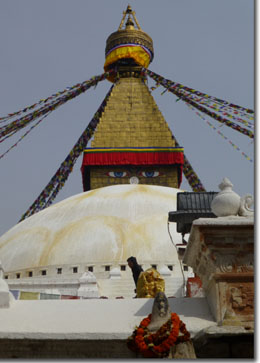
Our first stop of the day was a tour of the Pashupatinath Temple, which is devoted to Lord Shiva. It has a two tiered golden roof, and is considered one of the holiest shrines for Hindus. The place is on the UNESCO World Heritage Site List for 1979. You can’t go in, as the dome is a solid structure. When it was built, supposedly some relics from Buddha were placed inside.

The temple is inside an urbaqn square, and surrounded by shops. Needless to say, you could purchase whatever you wanted. Need a rooftop view? No problem. Scarves, beads, jewelry, hats, prayer wheels? We got 'em.

This time of year was part of the Sherpa Loham Holiday, or New Year. So there were plenty of people walking around the place (clockwise only), and the costuming was pretty terrific.
The Sherpas were easy to distinguish from the colorful aprons and hats. Between the faithful, walking, or prostrating themselves, the locals in for the holiday, and the tourists, it was quite crowded.
 The whole thing is whitewashed several times a
year, which is done by mixing milk with limestone.
The resulting paint mixture is then just rolled on.
The whole thing is whitewashed several times a
year, which is done by mixing milk with limestone.
The resulting paint mixture is then just rolled on.
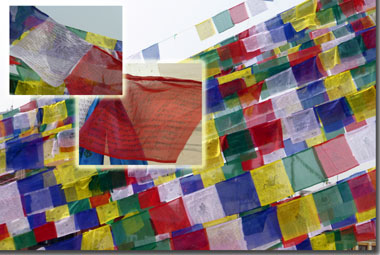
The prayer flags were colorful and many. You can have a special message put on, and your flag is attached to a line which is run from the steeple of the stupa, down to the roofs edge.
 The second stop on the way to the airport was
the Boudhanath Stupa, which is the world’s largest stupa and a sight of
great respect for the world’s Buddhists.
It is the center of the Buddhist religion here in Nepal.
The second stop on the way to the airport was
the Boudhanath Stupa, which is the world’s largest stupa and a sight of
great respect for the world’s Buddhists.
It is the center of the Buddhist religion here in Nepal.
We couldn’t go in, as we are non-believers, but were able to explore the grounds, complete with animals of various sorts, and colorful devotees, either in saffron garb or just plain old ashes.

There are many colorful depictions of Lord Shiva, Brahma, and Ganesha. Note again the rather child-like look of the figures.

The faithful were here, in all forms and shapes, from the saffron robed, to those merely covered in ashes.
 This
temple is built on a tributary of the Ganges,
so cremations were going on here as well.
In fact, you got a better look at things than in Varanasi, as you
could get closer.
This
temple is built on a tributary of the Ganges,
so cremations were going on here as well.
In fact, you got a better look at things than in Varanasi, as you
could get closer.
The one annoying thing here, though, were the souvenier sellers. They were so persistent and "in your face" agressive. I know they are trying to make a buck from “wealthy” tourists, but this was over the top as far as I was concerned. The Indian guys were NOT this bad.
 And
this photo has no bearing on anything, other than the fact that I really
liked the color. I think it is chalk. And I thought it was
very colorful.
And
this photo has no bearing on anything, other than the fact that I really
liked the color. I think it is chalk. And I thought it was
very colorful.
We are ensconced in the Kathmandu Airport, which as I mentioned, is a rather humble little place. But people come here for the adventure such as trekking, rafting, climbing and the like. So grandeur is not what is needed here. The airport suits the surroundings.
Once we get to Delhi, we are in for an arduous trek home. But before we leave, we had a brief stop in another Oberoi property, the Oberoi Gurgaon. Located close to the airport, it is a place to chill for five hours – in high style, I might add – and a shower, before we head back to Indira Gandhi Airport.
Our next flight leaves for Dubai at 0400
(delayed to 0445), arriving at 0600.
Departure from Dubai is at 0930 with an anticipated arrival in Seattle
at 1230 or so, and only wish it would take 3 hours instead of the
15 or so with the time shift.
Then it is on to Phoenix at 1830.
We should get home around midnight.
On the plus side, we will have memories of an amazing adventure.
On the minus side, I have almost 2000 images that I took on this
trip. Drat digital cameras.
So by the time you read this, think of what I had to triage to
get what is there.
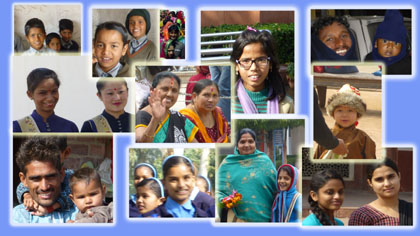 This has been a fantastic trip of almost a
month. The three countries
were so different, and each so enjoyable.
As I previously mentioned, we weren’t real keen to do this one.
But we are so glad we did.
India is an amazing adventure, and we would not have missed it
for anything.
This has been a fantastic trip of almost a
month. The three countries
were so different, and each so enjoyable.
As I previously mentioned, we weren’t real keen to do this one.
But we are so glad we did.
India is an amazing adventure, and we would not have missed it
for anything.
Our main recollections are:
tomato soup and grilled cheese sandwiches, without which we would
have started. Narrow
storefronts, with immaculatey clean interiors admidst trash littered
ground. Mountain vistas.
Sparkling lakes, filty pools of water.
The ghats, forts and palaces, palaces and forts.
Chaotic yet flowing traffic, brightly painted tuk tiks, the Eyes
of Buddha, and smiles, smiles, smiles.